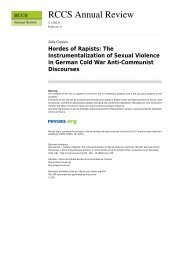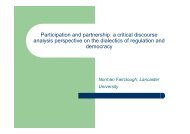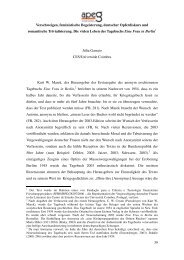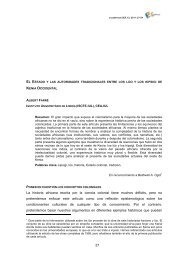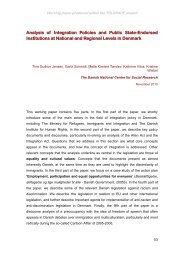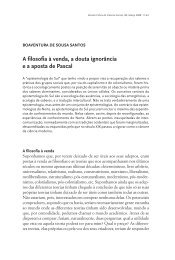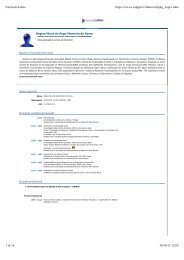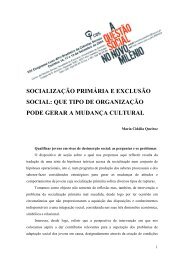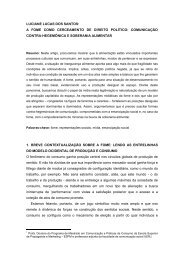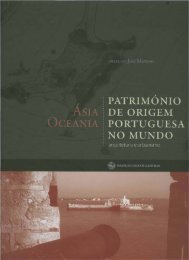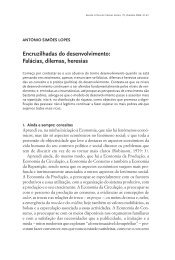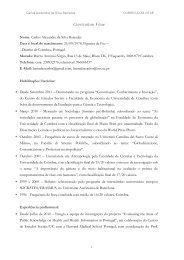(anti)discrimination in Danish Primary and Lower Education
(anti)discrimination in Danish Primary and Lower Education
(anti)discrimination in Danish Primary and Lower Education
You also want an ePaper? Increase the reach of your titles
YUMPU automatically turns print PDFs into web optimized ePapers that Google loves.
Work<strong>in</strong>g paper produced with<strong>in</strong> the TOLERACE project<br />
Integration, Difference <strong>and</strong> (<strong>anti</strong>)<strong>discrim<strong>in</strong>ation</strong> <strong>in</strong> <strong>Danish</strong><br />
<strong>Primary</strong> <strong>and</strong> <strong>Lower</strong> <strong>Education</strong><br />
Summary<br />
T<strong>in</strong>a Gudrun Jensen, Mette Kirst<strong>in</strong>e Tørslev, Kathr<strong>in</strong>e Vitus <strong>and</strong> Krist<strong>in</strong>a Weibel<br />
The <strong>Danish</strong> National Centre for Social Research<br />
February 2012<br />
The aim of this case study is to analyse how <strong>discrim<strong>in</strong>ation</strong> <strong>and</strong> racism are formulated <strong>in</strong><br />
the context of the <strong>Danish</strong> public school, the Folkeskole. The paper is based on a case<br />
study compris<strong>in</strong>g policy studies <strong>and</strong> <strong>in</strong>terviews with school leaders <strong>and</strong> teachers from the<br />
Folkeskole, as well as representatives from national <strong>and</strong> local authorities <strong>and</strong> <strong>Danish</strong><br />
NGO´s. Research about school performances show that ethnic m<strong>in</strong>ority children perform<br />
significantly worse than ethnic majority children; between 47 to 55 pct. of ethnic m<strong>in</strong>ority<br />
children <strong>in</strong> the 9.th grade are considered ‟functional illiterate‟ compared to only 14 pct. of<br />
ethnic majority children. Research about <strong>in</strong>- <strong>and</strong> exclusion of ethnic m<strong>in</strong>ority <strong>in</strong><br />
Folkeskolen to a very small degree focuses on <strong>discrim<strong>in</strong>ation</strong> or <strong>anti</strong>-racism when<br />
explor<strong>in</strong>g <strong>and</strong> discuss<strong>in</strong>g the legal, social <strong>and</strong> emotional conditions for <strong>and</strong> school results<br />
of ethnic m<strong>in</strong>ority students. There has been an obvious lack of <strong>in</strong>terest <strong>in</strong> multicultural or<br />
<strong>anti</strong>-racist pedagogy the last decade. Discrim<strong>in</strong>ation <strong>and</strong> racism is not specifically<br />
addressed <strong>in</strong> the <strong>Danish</strong> educational law, but an action plan on equal treatment from 2010<br />
<strong>in</strong>cludes <strong>in</strong>itiatives aim<strong>in</strong>g at combatt<strong>in</strong>g prejudices <strong>and</strong> <strong>in</strong>tolerance through dissem<strong>in</strong>ation<br />
of knowledge on <strong>discrim<strong>in</strong>ation</strong>. Discrim<strong>in</strong>ation is perceived as <strong>in</strong>dividual acts <strong>and</strong> most<br />
<strong>in</strong>itiatives targets students. Mother-tongue education is an issue of debate <strong>in</strong> Denmark.<br />
S<strong>in</strong>ce 2002 only bil<strong>in</strong>gual students from EU/EEA countries are entitled free mother-tongue<br />
tuition, caus<strong>in</strong>g critique from various sides (e.g. researchers <strong>and</strong> ECRI) for be<strong>in</strong>g <strong>in</strong><br />
violation of equal rights.<br />
Differ<strong>in</strong>g positions <strong>and</strong> voices reveal ambiguities <strong>and</strong> no straightforward consensus<br />
on the issue of <strong>discrim<strong>in</strong>ation</strong> <strong>and</strong> racism. Teachers <strong>and</strong> school leaders agree, however,<br />
on the importance of not treat<strong>in</strong>g bil<strong>in</strong>gual students differently from other students,<br />
believ<strong>in</strong>g that all students benefit the most from be<strong>in</strong>g treated the same. The dilemma of<br />
this idea is that social position<strong>in</strong>g of bil<strong>in</strong>gual students is determ<strong>in</strong>ed by the pervad<strong>in</strong>g<br />
striv<strong>in</strong>g for equality <strong>in</strong> the sense of sameness. In this perspective, be<strong>in</strong>g different becomes<br />
59
Work<strong>in</strong>g paper produced with<strong>in</strong> the TOLERACE project<br />
a problem per se. The general emphasis of equality <strong>and</strong> sameness that predom<strong>in</strong>ates<br />
<strong>Danish</strong> society, (re)produc<strong>in</strong>g the hegemonic <strong>in</strong>tegration discourse, allows no room for talk<br />
of <strong>discrim<strong>in</strong>ation</strong>. A refusal or hesitancy to speak about <strong>discrim<strong>in</strong>ation</strong>, even when issues<br />
of for example recognition or equal rights come up, <strong>in</strong>dicates not only lack of a legitimate<br />
language to address <strong>discrim<strong>in</strong>ation</strong>, but also lack<strong>in</strong>g recognition of the fact that a<br />
legitimate language is absent. Efforts towards equal opportunities for everyone – the<br />
combat of <strong>discrim<strong>in</strong>ation</strong> – are thus dissolved <strong>in</strong> colour-bl<strong>in</strong>d <strong>in</strong>itiatives towards democracy<br />
<strong>and</strong> citizenship.<br />
Introduction<br />
The aim of this case study is to analyse how racism <strong>and</strong> <strong>discrim<strong>in</strong>ation</strong> are formulated <strong>in</strong> the context of<br />
the <strong>Danish</strong> public school, the Folkeskole. Focus<strong>in</strong>g on social constructions of „otherness‟ <strong>and</strong><br />
(non)verbalizations of racism <strong>and</strong> <strong>discrim<strong>in</strong>ation</strong>, the analysis will explore how ethnic m<strong>in</strong>ority students<br />
are positioned <strong>in</strong> the Folkeskole. Apply<strong>in</strong>g a discourse analytical framework we analyse how questions<br />
of equal treatment, (<strong>anti</strong>)<strong>discrim<strong>in</strong>ation</strong> <strong>and</strong> (<strong>anti</strong>)racism are approached <strong>in</strong> primary <strong>and</strong> lower<br />
education.<br />
Racism is a contested concept (Rizvi, 1993; Troyna 1993). Rather than be<strong>in</strong>g<br />
simply a term<strong>in</strong>ological issue, it is <strong>in</strong>herently practical: how do we expla<strong>in</strong> racism‟s<br />
persistence <strong>and</strong> how do we develop <strong>anti</strong>-racist <strong>in</strong>itiatives (Rizvi, 1993: p2)? Two<br />
approaches to racism <strong>in</strong> education are present <strong>in</strong> western political <strong>and</strong> pedagogical<br />
debate; the multicultural <strong>and</strong> the <strong>anti</strong>racist approach or discourse. With<strong>in</strong> a multicultural<br />
discourse, racism is typically assumed to be primarily a product of ignorance, perpetuated<br />
by negative attitudes <strong>and</strong> <strong>in</strong>dividual prejudice, while the <strong>anti</strong>racist approach addresses<br />
<strong>and</strong> analyses racism as both <strong>in</strong>dividualized acts <strong>and</strong> societal structural occurrences<br />
(Sarup, 1993: p33).<br />
Analys<strong>in</strong>g questions of diversity <strong>in</strong> <strong>Danish</strong> public schools, the discourses draw<strong>in</strong>g<br />
on multicultural <strong>and</strong> <strong>anti</strong>-racist theory constitute a relevant theoretical framework.<br />
However, focus<strong>in</strong>g on the specific <strong>Danish</strong> educational context, a third discourse<br />
predom<strong>in</strong>ates; the „<strong>in</strong>tegration discourse‟ (Gilliam, 2009).<br />
This case study takes place <strong>in</strong> Copenhagen <strong>and</strong> is based on a comb<strong>in</strong>ation of qualitative<br />
methods: a focus group <strong>in</strong>terview, 12 <strong>in</strong>dividual <strong>in</strong>terviews, participant observation at a<br />
school workshop (campaign aga<strong>in</strong>st racism <strong>in</strong> sports <strong>and</strong> society) <strong>and</strong> a policy study of<br />
state educational policies regard<strong>in</strong>g <strong>in</strong>tegration <strong>and</strong> (<strong>anti</strong>) racism <strong>in</strong> the <strong>Danish</strong> primary<br />
<strong>and</strong> lower secondary school (The Folkeskole). The <strong>in</strong>formants <strong>in</strong>clude school leaders <strong>and</strong><br />
teachers from the Folkeskole <strong>in</strong> Copenhagen, representatives from national <strong>and</strong> local<br />
authorities <strong>and</strong> <strong>Danish</strong> NGO´s. The empirical data was collected <strong>in</strong> the period from April to<br />
October 2011.<br />
60
Work<strong>in</strong>g paper produced with<strong>in</strong> the TOLERACE project<br />
1. Context <strong>and</strong> previous research<br />
The unit of analysis of this case study is the <strong>Danish</strong> public primary <strong>and</strong> lower education;<br />
the Folkeskole. This section describes the overall context for <strong>and</strong> research on the <strong>Danish</strong><br />
Fokeskole.<br />
1.1 <strong>Danish</strong> primary <strong>and</strong> lower education<br />
The basic education <strong>in</strong> Denmark is provided either by the public Folkeskole or the private<br />
elementary schools, which have the same structure <strong>and</strong> are known as „free elementary<br />
schools‟. The Folkeskole comprises a one-year nursery class, a n<strong>in</strong>e-year basic school<br />
<strong>and</strong> a one-year 10 th grade class. Only the n<strong>in</strong>e-year basic school is compulsory. On<br />
complet<strong>in</strong>g 9 th or 10 th grade pupils can take the f<strong>in</strong>al Folkeskole exam<strong>in</strong>ation.<br />
The curriculum is determ<strong>in</strong>ed by the <strong>Education</strong> Act, while regulations concern<strong>in</strong>g<br />
the aims of different subjects are drawn up by the M<strong>in</strong>ister of <strong>Education</strong> <strong>in</strong> accordance<br />
with the law. However, local authorities have the ultimate responsibility for the Folkeskole,<br />
<strong>in</strong>clud<strong>in</strong>g appo<strong>in</strong>tments, f<strong>in</strong>ancial framework <strong>and</strong> curricula. Every school has a board of<br />
governors <strong>in</strong> which parents representatives are <strong>in</strong> the majority. This board determ<strong>in</strong>es the<br />
pr<strong>in</strong>ciples for the school‟s activities, draws up proposals for curricula <strong>and</strong> approves<br />
teach<strong>in</strong>g materials that are made available to the pupils for free. The school leader has<br />
the educational <strong>and</strong> adm<strong>in</strong>istrative responsibility for the school, while the teachers have a<br />
considerable degree of freedom concern<strong>in</strong>g contents <strong>and</strong> teach<strong>in</strong>g methods.<br />
In 2008, approximately 91,000 children attended 510 private schools, while<br />
590,000 pupils attended the Folkeskole, of which there are approximately 1600. About<br />
14% of all children at basic school level (<strong>in</strong>clud<strong>in</strong>g the voluntary preschool class <strong>and</strong> 10th<br />
form) thus attend private schools. In the Folkeskole there are approximately 60.000<br />
bil<strong>in</strong>gual pupils (The <strong>Danish</strong> M<strong>in</strong>istry of <strong>Education</strong>, 2008; 2010).<br />
1.2 Previous research on ethnic m<strong>in</strong>ority children <strong>in</strong> the <strong>Danish</strong> Folkeskole<br />
Research literature about ethnic m<strong>in</strong>ority children <strong>in</strong> the <strong>Danish</strong> Folkeskole generally falls<br />
<strong>in</strong>to two groups: one qu<strong>anti</strong>tatively based on survey material <strong>and</strong> statistics focus<strong>in</strong>g on<br />
school performances, <strong>and</strong> another qualitatively based on ethnographic fieldwork <strong>and</strong><br />
qualitative <strong>in</strong>terview focus<strong>in</strong>g on social processes of ethnic, gender <strong>and</strong> student identity<br />
formation, <strong>and</strong> <strong>in</strong>clusion/exclusion <strong>in</strong> <strong>and</strong> out of different subject positions.<br />
Research about school performances (Dahl 2005; Egelund & Rangvid 2005) show<br />
that ethnic m<strong>in</strong>ority children perform significantly worse than ethnic majority children.<br />
Thus, while between 47 to 55 pct. of ethnic m<strong>in</strong>ority children <strong>in</strong> the 9.th grade are<br />
61
Work<strong>in</strong>g paper produced with<strong>in</strong> the TOLERACE project<br />
considered ‟functional illiterate‟ (have difficulties <strong>in</strong> transferr<strong>in</strong>g what they learn <strong>in</strong> school to<br />
other contexts), only 14 pct. of ethnic majority children are considered so (Dahl 2005:20).<br />
Research about social processes of identity formation, <strong>in</strong>- <strong>and</strong> exclusion for ethnic<br />
m<strong>in</strong>ority <strong>in</strong> Folkeskolen to a very small degree focuses on <strong>discrim<strong>in</strong>ation</strong> or <strong>anti</strong>-racism<br />
when explor<strong>in</strong>g <strong>and</strong> discuss<strong>in</strong>g the legal, social <strong>and</strong> emotional conditions for <strong>and</strong> school<br />
results of ethnic m<strong>in</strong>ority students. Generally there has been an obvious lack of <strong>in</strong>terest <strong>in</strong><br />
multicultural or <strong>anti</strong>-racist pedagogy the last decade (Horst 2003), <strong>and</strong> a lack of discussion<br />
of the potentials of such pedagogical approaches (Kampmann2003:112).<br />
There may be various explanations of these trends <strong>in</strong> m<strong>in</strong>ority research. With<strong>in</strong> the<br />
last decade of <strong>Danish</strong> neo-liberal education <strong>and</strong> immigration ideology that deliberately<br />
excludes perspectives of structural <strong>in</strong>equality or conflict between ethnic groups or<br />
systematic <strong>in</strong>justice from the school system aga<strong>in</strong>st certa<strong>in</strong> groups of students, focus has<br />
unequivocally been centered on school performances <strong>and</strong> skills of ethnic m<strong>in</strong>ority<br />
children, communicated through policy concepts (Apthope 1997) or empty signifiers<br />
(Laclau 1996) like equal treatment, <strong>in</strong>tegration <strong>and</strong> subjective <strong>discrim<strong>in</strong>ation</strong> (see DK-WP<br />
1 & 2). The lack of studies focus<strong>in</strong>g on issues of <strong>discrim<strong>in</strong>ation</strong> or <strong>anti</strong>-racism may reflect<br />
the <strong>in</strong>fluences on researchers from this political trend. Another obvious explanation is that<br />
local political focus <strong>in</strong> <strong>Danish</strong> schools has been framed by the same ideological trend,<br />
affect<strong>in</strong>g both actual school policies <strong>and</strong> rhetoric about ethnic <strong>and</strong> cultural diversity. Thus,<br />
even if researchers would want to study <strong>discrim<strong>in</strong>ation</strong> <strong>and</strong> <strong>anti</strong>-racism <strong>in</strong> the <strong>Danish</strong><br />
Folkeskole, they would most likely f<strong>in</strong>d other k<strong>in</strong>ds of native expressions for or ways of<br />
rephras<strong>in</strong>g such processes among teachers <strong>and</strong> students, expressions that are<br />
concordant with the <strong>Danish</strong> „<strong>in</strong>tegration discourse‟ (see below).<br />
2. Theoretical focus<br />
Apply<strong>in</strong>g a discourse analytical framework, the aim of this case study is to analyse how<br />
<strong>discrim<strong>in</strong>ation</strong> <strong>and</strong> racism are formulated <strong>in</strong> the context of the <strong>Danish</strong> Folkeskole.<br />
Two approaches to racism <strong>in</strong> education are present <strong>in</strong> western political <strong>and</strong><br />
pedagogical debate; the multicultural <strong>and</strong> the <strong>anti</strong>racist approach or discourse. With<strong>in</strong> a<br />
multicultural discourse, racism is typically assumed to be primarily a product of ignorance,<br />
perpetuated by negative attitudes <strong>and</strong> <strong>in</strong>dividual prejudice. Racism is thus constituted as<br />
an <strong>in</strong>dividualized, exceptional phenomenon, which implies that social structures <strong>and</strong><br />
<strong>in</strong>stitutions cannot be racist, only <strong>in</strong>dividuals can (Rizvi, 1993: 7). To counteract racism,<br />
this theory suggests that “where <strong>in</strong>dividuals are prejudiced, they must be tra<strong>in</strong>ed to<br />
62
Work<strong>in</strong>g paper produced with<strong>in</strong> the TOLERACE project<br />
become more rational […] this theory assumes that racism is restricted to a few „rotten<br />
apples‟ <strong>in</strong> a basket that is basically sound” (Rizvi, 1993: 7).<br />
The multicultural approach thus stresses knowledge about other cultures.<br />
However, as advocates of the <strong>anti</strong>racist approach argue: people can be well <strong>in</strong>formed <strong>and</strong><br />
still be racist (Sarup, 1991: 29). While the multicultural education teaches of other<br />
cultures, emphasiz<strong>in</strong>g to break down stereotypes <strong>and</strong> promote greater tolerance of<br />
diversity <strong>in</strong> society, it focuses on a „celebration‟ of cultures rather than on political<br />
processes <strong>and</strong> economic structures: “Much of this „soft‟ multicultural education, then, is<br />
tokenistic, but it is more than that; as it is <strong>in</strong>volved <strong>in</strong> an ideological struggle it actually tries<br />
to prevent radical social change” (Sarup, 1991: 30). This means that the multicultural<br />
approach <strong>in</strong>stead of counteract<strong>in</strong>g racism to some extend legitimizes <strong>and</strong> reproduces<br />
(potential) structures of racism <strong>and</strong> <strong>discrim<strong>in</strong>ation</strong> due to an <strong>in</strong>herent denial of structural<br />
<strong>discrim<strong>in</strong>ation</strong> (Sarup, 1993).<br />
The <strong>anti</strong>racist approach differs significantly from the multicultural approach as it <strong>in</strong><br />
addition to see racism as <strong>in</strong>dividual acts, addresses racism as structural societal<br />
<strong>in</strong>equalities. This approach thus analyses racism <strong>in</strong> both <strong>in</strong>terpersonal (conscious or<br />
unconscious, prejudices, stereotyp<strong>in</strong>g etc.), <strong>in</strong>stitutional („taken-for-granted‟ customs,<br />
rout<strong>in</strong>e practices <strong>and</strong> procedures) <strong>and</strong> state (policy <strong>and</strong> law) level (Sarup, 1993: 33).<br />
In analyses of how questions of diversity are approached <strong>in</strong> <strong>Danish</strong> schools, the<br />
two discourses draw<strong>in</strong>g on multicultural <strong>and</strong> <strong>anti</strong>-racist theory are also present. However,<br />
focus<strong>in</strong>g on a <strong>Danish</strong> educational context, previous studies describe a third discourse; the<br />
dom<strong>in</strong>ant „<strong>in</strong>tegration discourse‟ (Gilliam, 2009: 97).<br />
The „<strong>in</strong>tegration discourse‟ describes ethnic m<strong>in</strong>ority children as children that<br />
socially, culturally, l<strong>in</strong>guistically are different <strong>and</strong> st<strong>and</strong> outside „normal‟ <strong>Danish</strong> society,<br />
<strong>and</strong> need to be <strong>in</strong>tegrated <strong>in</strong> school, <strong>and</strong> through school <strong>in</strong>tegrated <strong>in</strong>to society (Gilliam<br />
2009). Also, the discourse presumes that „<strong>in</strong>tegration‟ takes place when these<br />
marg<strong>in</strong>alised children <strong>in</strong>teract with <strong>Danish</strong> children <strong>and</strong> acquire knowledge about the<br />
<strong>Danish</strong> language, society <strong>and</strong> political system, <strong>and</strong> learn (are taught) the necessary<br />
competencies <strong>in</strong> order to participate productively <strong>and</strong> as democratic citizens <strong>in</strong> <strong>Danish</strong><br />
society. The <strong>in</strong>tegration discourse terms ethnic m<strong>in</strong>ority children „bil<strong>in</strong>gual children‟, <strong>and</strong><br />
addresses the bil<strong>in</strong>gual problem as one that needs to be solved through special measures<br />
that aims at strengthen<strong>in</strong>g the children‟s <strong>Danish</strong> l<strong>in</strong>guistic abilities as the school‟s most<br />
important cultural capital (Gitz-Johansen 2006:152-3). In this way „<strong>in</strong>tegration‟ is turned<br />
<strong>in</strong>to a technical problem that needs to be fixed from an apolitical pedagogical didactic<br />
approach.<br />
The <strong>in</strong>tegration discourse however, is based on an underst<strong>and</strong><strong>in</strong>g of „<strong>in</strong>tegration‟<br />
that is <strong>in</strong> essence assimilation: ethnic m<strong>in</strong>ority children are expected to undergo the same<br />
63
Work<strong>in</strong>g paper produced with<strong>in</strong> the TOLERACE project<br />
formative processes as ethnic <strong>Danish</strong> children – acquir<strong>in</strong>g the <strong>Danish</strong> language – <strong>and</strong> are<br />
thus neutralized as social categories <strong>and</strong> zs students. The best example of this<br />
assimilatory underst<strong>and</strong><strong>in</strong>g of „<strong>in</strong>tegration‟ is that ethnic m<strong>in</strong>ority students that are called<br />
„<strong>in</strong>tegrated‟ are those considered to be the „most <strong>Danish</strong>‟ children (Gitz-Johansen<br />
2006:268). Thus, while at the on h<strong>and</strong> focus<strong>in</strong>g on language skills, on the other h<strong>and</strong> this<br />
slide between l<strong>in</strong>guistic „<strong>in</strong>tegratedness‟ <strong>and</strong> „<strong>Danish</strong>ness‟ shows the ambiguity of the<br />
„<strong>in</strong>tegration discourse‟: is embraces at the same time an assimilatory <strong>and</strong> a multicultural<br />
discourse <strong>and</strong> therefore succeeds <strong>in</strong> simultaneously creat<strong>in</strong>g consensus between<br />
oppos<strong>in</strong>g ideals <strong>and</strong> dem<strong>and</strong>s (Gilliam 2009:98).<br />
3. State educational policies regard<strong>in</strong>g <strong>in</strong>tegration <strong>and</strong> (<strong>anti</strong>-)racism <strong>in</strong><br />
the <strong>Danish</strong> primary <strong>and</strong> lower secondary school (The Folkeskole)<br />
On the national level, the <strong>Danish</strong> primary <strong>and</strong> lower secondary school is regulated by the<br />
Folkeskole Act (<strong>Education</strong> Act), which provides the overall framework for the schools‟<br />
activities. The ma<strong>in</strong> purposes of the public school (Folkeskole) are to:<br />
“… provide students with the knowledge <strong>and</strong> skills that will prepare them for further education <strong>and</strong><br />
tra<strong>in</strong><strong>in</strong>g <strong>and</strong> <strong>in</strong>still <strong>in</strong> them the desire to learn more; familiarize them with <strong>Danish</strong> culture <strong>and</strong> history;<br />
give them an underst<strong>and</strong><strong>in</strong>g of other countries <strong>and</strong> cultures; contribute to their underst<strong>and</strong><strong>in</strong>g of the<br />
<strong>in</strong>terrelationship between human be<strong>in</strong>gs <strong>and</strong> the environment; <strong>and</strong> promote the well-rounded<br />
development of the <strong>in</strong>dividual student…prepare the students to be able to participate, demonstrate<br />
mutual responsibility <strong>and</strong> underst<strong>and</strong> their rights <strong>and</strong> duties <strong>in</strong> a free <strong>and</strong> democratic society. The daily<br />
activities of the school must, therefore, be conducted <strong>in</strong> a spirit of <strong>in</strong>tellectual freedom, equality <strong>and</strong><br />
democracy” (<strong>Danish</strong> Government, The <strong>Education</strong> Act § 1).<br />
All municipal primary <strong>and</strong> lower secondary schools share a common aim <strong>and</strong> st<strong>and</strong>ard<br />
requirements concern<strong>in</strong>g the subjects that are to be taught. However, it is the<br />
responsibility of the <strong>in</strong>dividual municipalities to determ<strong>in</strong>e how the schools are to be<br />
organised <strong>in</strong> practice, with<strong>in</strong> the framework established by law. In addition, many concrete<br />
decisions are further decentralised to school boards, pr<strong>in</strong>cipals <strong>and</strong> <strong>in</strong>dividual teachers.<br />
This for example concerns the choice of schoolbooks <strong>and</strong> materials. There may be both<br />
advantages <strong>and</strong> disadvantages of the locally adm<strong>in</strong>istered public school. On one h<strong>and</strong>, it<br />
allows for a high degree of contextualization <strong>and</strong> flexibility. On the other h<strong>and</strong>, the<br />
absence of centrally set st<strong>and</strong>ards can lead to very different conditions, practices <strong>and</strong><br />
approaches at the schools when it comes to deal<strong>in</strong>g with religious, l<strong>in</strong>guistic <strong>and</strong> cultural<br />
differences (Documentary <strong>and</strong> Advisory Center on Racial Discrim<strong>in</strong>ation (DACoRD),<br />
2004).<br />
The <strong>Education</strong> Act conta<strong>in</strong>s a number of Executive Orders. The three most<br />
important <strong>in</strong> this context concern the promotion of good order, mother-tongue tuition <strong>and</strong><br />
64
Work<strong>in</strong>g paper produced with<strong>in</strong> the TOLERACE project<br />
education <strong>in</strong> <strong>Danish</strong> as a second language. In the Executive Order for the Promotion of<br />
Good Order <strong>in</strong> the Public School, guidel<strong>in</strong>e regulations are set forth outl<strong>in</strong><strong>in</strong>g the schools‟<br />
responsibility to establish codes of conduct, <strong>in</strong>clud<strong>in</strong>g an <strong>anti</strong>-mobb<strong>in</strong>g strategy, <strong>and</strong> the<br />
discipl<strong>in</strong>ary actions they can legally take regard<strong>in</strong>g the students, for example <strong>in</strong> cases of<br />
mobb<strong>in</strong>g. While the <strong>Education</strong> Act explicitly addresses mobb<strong>in</strong>g it seems somewhat<br />
unclear, how the concept is def<strong>in</strong>ed <strong>and</strong> what it encompasses. It is not specified if ethnic<br />
<strong>discrim<strong>in</strong>ation</strong> <strong>and</strong> racism are <strong>in</strong>cluded <strong>in</strong> the <strong>anti</strong>-mobb<strong>in</strong>g efforts <strong>and</strong> if so, how these<br />
phenomena are related to mobb<strong>in</strong>g. However, what is clear is that racism <strong>and</strong><br />
<strong>discrim<strong>in</strong>ation</strong> are not specifically addressed <strong>in</strong> the guidel<strong>in</strong>e regulations.<br />
In relation to mother-tongue education, the rules were changed <strong>in</strong> 2002 so that<br />
only children from Member States of the European Economic Area, the Faeroe Isl<strong>and</strong>s<br />
<strong>and</strong> Greenl<strong>and</strong> are entitled to free mother-tongue tuition. The municipalities are not<br />
forbidden to offer mother-tongue education to all bil<strong>in</strong>gual students, but they no longer<br />
receive f<strong>in</strong>ancial support from the state to do so (<strong>Danish</strong> Government, Executive order on<br />
mother tongue education, DACoRD, 2004). This has led to a decrease <strong>in</strong> ethnic m<strong>in</strong>ority<br />
students‟ access to teach<strong>in</strong>g <strong>in</strong> their mother tongue <strong>and</strong> a national mapp<strong>in</strong>g from 2008<br />
showed that only 5 out of 98 municipalities were offer<strong>in</strong>g mother-tongue teach<strong>in</strong>g to<br />
students from third countries on completely equal terms with students from the EU/EØS<br />
countries (Timm, 2008). In this way a divid<strong>in</strong>g l<strong>in</strong>e is drawn between children from the<br />
EU/EØS countries, who are entitled to free mother-tongue teach<strong>in</strong>g <strong>and</strong> children from third<br />
countries, who are not. This compromises the <strong>Danish</strong> pr<strong>in</strong>ciple of equality that<br />
emphasizes equality of opportunities regardless of ethnicity, gender, age etc.<br />
The removal of the right to free mother-tongue teach<strong>in</strong>g for all bil<strong>in</strong>gual children<br />
has been criticized from various sides for ignor<strong>in</strong>g national <strong>and</strong> <strong>in</strong>ternational research <strong>and</strong><br />
recommendations concern<strong>in</strong>g mother tongue education <strong>and</strong> for discrim<strong>in</strong>at<strong>in</strong>g aga<strong>in</strong>st<br />
certa<strong>in</strong> groups of children (ECRI, 2006; FRA, 2010; Kristjánsdóttir & Timm, 2007;<br />
DACoRD, 2004). In its third report on Denmark ECRI strongly recommended that mother<br />
tongue education is offered to children on a non-discrim<strong>in</strong>atory basis <strong>and</strong> that public<br />
schools should focus on <strong>in</strong>tegration <strong>in</strong>stead of assimilation (ECRI, 2006). As a response to<br />
this critique the former M<strong>in</strong>ister of <strong>Education</strong>, Ulla Tørnæs, said:<br />
“It is not unambiguously proved that mother tongue education leads to better <strong>in</strong>tegration. I believe it is<br />
the school‟s responsibility to teach children <strong>Danish</strong>. It is the language we speak <strong>in</strong> Denmark, <strong>and</strong> it<br />
gives the students the best opportunities to succeed academically <strong>and</strong> socially” (Ulla Tørnæs <strong>in</strong><br />
Politiken, 2004).<br />
This lack of priority given to mother tongue education seems to reflect a widespread<br />
perception <strong>in</strong> the <strong>Danish</strong> school system <strong>and</strong> <strong>in</strong> <strong>Danish</strong> society more broadly of different<br />
mother tongues as a problem rather than as a resource. Instead of recognis<strong>in</strong>g students‟<br />
65
Work<strong>in</strong>g paper produced with<strong>in</strong> the TOLERACE project<br />
knowledge of other languages as an asset <strong>and</strong> an important goal <strong>in</strong> itself, focus seems to<br />
be on ethnic m<strong>in</strong>ority students‟ deficits <strong>and</strong> lack of <strong>Danish</strong> language skills (Nusche et al.,<br />
2010; Kristjánsdóttir & Timm, 2007). OECD states:<br />
“Through the complete exclusion of immigrant languages <strong>in</strong> school life, the education system is<br />
miss<strong>in</strong>g a chance to affirm immigrants‟ additional knowledge <strong>and</strong> cultural <strong>and</strong> l<strong>in</strong>guistic background <strong>in</strong> a<br />
positive way, as an opportunity <strong>and</strong> not just a challenge” (Nusche et al., 2010:35).<br />
This lack of recognition of the other languages than <strong>Danish</strong> seems to reflect a general<br />
uneas<strong>in</strong>ess with difference <strong>and</strong> a tendency to underst<strong>and</strong> <strong>in</strong>tegration as assimilation.<br />
Focus is on cultural <strong>and</strong> l<strong>in</strong>guistic sameness <strong>and</strong> <strong>in</strong>tegration becomes a question of<br />
immigrants‟ cultural capacity to harmonize their values with <strong>Danish</strong> values (Hamburger,<br />
1990; Jensen, 2010). With<strong>in</strong> this „<strong>in</strong>tegration discourse‟ ethnic m<strong>in</strong>ority children is<br />
expected to undergo the same formative processes as ethnic <strong>Danish</strong> children – acquir<strong>in</strong>g<br />
the <strong>Danish</strong> language – <strong>and</strong> are thus neutralized as social categories <strong>and</strong> st<strong>and</strong>ardized as<br />
students. The notion of equality is central to this discourse, but the perception seems to<br />
be that equality requires a certa<strong>in</strong> degree of sameness. The more alike we are, the easier<br />
it is to susta<strong>in</strong> the idea of equality. To be equal <strong>in</strong> <strong>Danish</strong> society, thus tend to imply to be<br />
similar (Hervik, 1999). This notion of equality is closely related to the perception of<br />
Denmark as a cultural homogeneous country, <strong>and</strong> to the conceptions of social<br />
egalitarianism <strong>and</strong> universalism as constitutive elements of <strong>Danish</strong> society (Hedetoft,<br />
2006).<br />
The discourse on <strong>in</strong>tegration as assimilation is to some extend reflected <strong>in</strong> the<br />
approach to <strong>Danish</strong> as a second language, which is offered to bil<strong>in</strong>gual children <strong>in</strong> primary<br />
<strong>and</strong> lower secondary schools if necessary <strong>and</strong> if so decided by the school pr<strong>in</strong>cipal<br />
(Executive Order on <strong>Danish</strong> as a Second Language). The underly<strong>in</strong>g assumption seems<br />
to be that language proficiency is a precondition for learn<strong>in</strong>g. However, at the school level,<br />
<strong>Danish</strong> as a second language is often limited to basic remedial programs outside normal<br />
school hours <strong>and</strong> the effort is concentrated around students <strong>in</strong> the first years of the<br />
primary school. Support is often not followed <strong>in</strong>to the later classes to enable immigrants to<br />
enhance their proficiency <strong>in</strong> academic <strong>Danish</strong> (Nusche et al., 2010). This contributes to<br />
create a perception of <strong>Danish</strong> as a second language as someth<strong>in</strong>g temporary,<br />
compensatory <strong>and</strong> exceptional <strong>and</strong> as a tool to be used “to solve a temporary structural<br />
problem <strong>in</strong> an assimilationist <strong>in</strong>tegration perspective” (Kristjánsdóttir & Timm, 2007:112).<br />
3.1 Anti-discrim<strong>in</strong>atory <strong>in</strong>itiatives <strong>in</strong> education<br />
66
Work<strong>in</strong>g paper produced with<strong>in</strong> the TOLERACE project<br />
The government´s Actionplan2010 has a number of <strong>in</strong>itiatives directed at combat<strong>in</strong>g<br />
<strong>discrim<strong>in</strong>ation</strong> <strong>and</strong> racism <strong>in</strong> primary <strong>and</strong> secondary school. Some aim at strengthen<strong>in</strong>g<br />
the students underst<strong>and</strong><strong>in</strong>g of citizenship, dialogue <strong>and</strong> democratic values through<br />
tra<strong>in</strong><strong>in</strong>g; others seek to combat prejudices <strong>and</strong> <strong>in</strong>tolerance through dissem<strong>in</strong>ation of<br />
knowledge <strong>and</strong> promotion of debates on <strong>discrim<strong>in</strong>ation</strong> <strong>and</strong> racism. While these <strong>in</strong>itiatives<br />
are primarily targeted students <strong>in</strong> primary <strong>and</strong> secondary school, others are directed at<br />
teachers; for example an attitud<strong>in</strong>al change campaign focus<strong>in</strong>g on the importance of<br />
meet<strong>in</strong>g ethnic m<strong>in</strong>ority students with an appreciative <strong>and</strong> resource based approach, <strong>and</strong><br />
the development of concrete methods <strong>and</strong> tools to be implemented <strong>in</strong> the teach<strong>in</strong>g.<br />
Common to these <strong>in</strong>itiatives is that they are all target<strong>in</strong>g <strong>in</strong>dividuals <strong>and</strong> that they aim at<br />
combat<strong>in</strong>g <strong>discrim<strong>in</strong>ation</strong> <strong>and</strong> racism through <strong>in</strong>formation <strong>and</strong> tra<strong>in</strong><strong>in</strong>g. The underly<strong>in</strong>g<br />
assumption seems to be that <strong>discrim<strong>in</strong>ation</strong> <strong>and</strong> racism are first <strong>and</strong> foremost products of<br />
ignorance, negative attitudes <strong>and</strong> <strong>in</strong>dividual prejudices. In this regard the government‟s<br />
<strong>anti</strong>-discrim<strong>in</strong>atory <strong>in</strong>itiatives <strong>in</strong> relation to education seem somewhat <strong>in</strong>spired by a<br />
multicultural approach, where racism is understood as an <strong>in</strong>dividualized, exceptional<br />
phenomenon that can be most adequately addressed through cultural awareness-rais<strong>in</strong>g<br />
<strong>and</strong> combat<strong>in</strong>g stereotypes (Avel<strong>in</strong>g, 2007; Sarup, 1991; Rizvi, 1993). While critiques of<br />
the multicultural approach acknowledge that knowledge of other cultures is an important<br />
element <strong>in</strong> combat<strong>in</strong>g racism, they do not believe that it is enough to achieve goals of<br />
cultural tolerance <strong>and</strong> <strong>in</strong>tercultural underst<strong>and</strong><strong>in</strong>g. As stated by Madan Sarup, people can<br />
be well <strong>in</strong>formed <strong>and</strong> still be racist (Sarup, 1991). Some of the same concerns have been<br />
raised <strong>in</strong> relation to the government‟s education policies <strong>and</strong> <strong>in</strong>itiatives aga<strong>in</strong>st<br />
<strong>discrim<strong>in</strong>ation</strong> <strong>in</strong> the education system. Kristjánsdottir & Timm (2007) accuse the<br />
educational policies for be<strong>in</strong>g discrim<strong>in</strong>atory aga<strong>in</strong>st ethnic m<strong>in</strong>ority students, s<strong>in</strong>ce they<br />
are based on a white <strong>Danish</strong> majority norm. They argue that the <strong>Danish</strong> educational<br />
system has rema<strong>in</strong>ed more or less the same over the last thirty years despite changes <strong>in</strong><br />
the student composition <strong>and</strong> <strong>in</strong>creased diversity <strong>in</strong> the classrooms. This means that ethnic<br />
m<strong>in</strong>ority students have no other choice than to adapt to the prevail<strong>in</strong>g conditions if they<br />
wish to succeed. Once aga<strong>in</strong> <strong>in</strong>tegration seems to be understood as assimilation <strong>and</strong> the<br />
presumption seems to be that „<strong>in</strong>tegration‟ takes place when ethnic m<strong>in</strong>ority children<br />
<strong>in</strong>teract with <strong>Danish</strong> children <strong>and</strong> learn about the <strong>Danish</strong> language, society <strong>and</strong> political<br />
system.<br />
The M<strong>in</strong>istry‟s perception of racism as mental prejudices held by a small number of<br />
unenlightened people implies that structural <strong>discrim<strong>in</strong>ation</strong> is not acknowledged. A<br />
representative of the M<strong>in</strong>istry states: “Fundamentally there are no structures <strong>in</strong> Denmark<br />
that are discrim<strong>in</strong>at<strong>in</strong>g. S<strong>in</strong>gle people or actions may be discrim<strong>in</strong>at<strong>in</strong>g, but we do not<br />
have a discrim<strong>in</strong>at<strong>in</strong>g education system, for <strong>in</strong>stance.” This view is also reflected <strong>in</strong> the<br />
67
Work<strong>in</strong>g paper produced with<strong>in</strong> the TOLERACE project<br />
Actionplan2010 that focuses on attitud<strong>in</strong>al changes <strong>and</strong> the victim‟s knowledge about their<br />
rights as the primary way to fight <strong>discrim<strong>in</strong>ation</strong>. Discrim<strong>in</strong>atory structures are not<br />
addressed <strong>and</strong>, therefore, neither are questions of power <strong>and</strong> racism <strong>in</strong> <strong>in</strong>ter-personal <strong>and</strong><br />
<strong>in</strong>stitutional contexts (Avel<strong>in</strong>g, 2007). This means that responsibility <strong>and</strong> blame implicitly<br />
rest on <strong>in</strong>dividuals – either the victims of <strong>discrim<strong>in</strong>ation</strong> or the few rotten apples <strong>in</strong> the<br />
basket that commit the discrim<strong>in</strong>at<strong>in</strong>g acts (Kristjánsdottir & Timm, 2007; Rizvi, 1993).<br />
This lack of focus on the structural aspects of <strong>discrim<strong>in</strong>ation</strong> <strong>and</strong> racism has been<br />
criticized for ignor<strong>in</strong>g embedded <strong>in</strong>equalities <strong>in</strong> the educational system <strong>and</strong> for overlook<strong>in</strong>g<br />
“the discreet, hidden, <strong>in</strong>visible <strong>and</strong> un<strong>in</strong>tentional attitude oriented cultural <strong>and</strong> <strong>in</strong>stitutional<br />
racism” (DACoRD, 2004:30).<br />
Another focus area <strong>in</strong> the Actionplan2010 that is directly related to education is „<strong>anti</strong>-<br />
Semitism <strong>and</strong> Intolerance‟, which is targeted by various <strong>in</strong>itiatives. Some of these<br />
<strong>in</strong>itiatives consist of develop<strong>in</strong>g <strong>and</strong> dissem<strong>in</strong>at<strong>in</strong>g educational material for primary <strong>and</strong><br />
secondary school, while others aim at <strong>in</strong>itiat<strong>in</strong>g dialogue groups among different groups<br />
that show <strong>in</strong>tolerance aga<strong>in</strong>st one another. While Actionplan2010 directly targets <strong>anti</strong>-<br />
Semitism, it has been criticized by The <strong>Danish</strong> Institute for Human Rights for not deal<strong>in</strong>g<br />
with islamophobia <strong>in</strong> <strong>Danish</strong> society, which is seen as a more widespread problem. The<br />
director of the department of Equal Treatment at the Institute describes <strong>anti</strong>-Semitism <strong>and</strong><br />
islamophobia as related problems; <strong>in</strong> both cases an entire group of people is put under<br />
suspicion <strong>and</strong> discrim<strong>in</strong>ated aga<strong>in</strong>st due to their religion. She therefore stresses the need<br />
to broaden the focus <strong>in</strong>stead of focus<strong>in</strong>g narrowly on just one dimension (The <strong>Danish</strong><br />
Institute for Human Rights, 2010).<br />
This lack of focus on Islamophobia is noteworthy s<strong>in</strong>ce several studies show that<br />
Danes´ attitudes towards religion are among the most negative <strong>in</strong> Europe (Goul Andersen,<br />
2002: 22). Particularly the image of Islam is constructed <strong>in</strong> opposition to ideas of <strong>anti</strong>-<br />
secularism, <strong>in</strong>dividualization <strong>and</strong> privatization of belief (ibid. 98), <strong>and</strong> the public debate to<br />
a large extent generates an opposition between <strong>Danish</strong> <strong>and</strong> Muslim identities,<br />
categoriz<strong>in</strong>g Islam <strong>and</strong> Muslim immigrants as <strong>in</strong>compatible with <strong>Danish</strong>ness <strong>and</strong> <strong>Danish</strong><br />
identity. ECRI has on several occasions expressed its concern about the general climate<br />
of <strong>in</strong>tolerance <strong>and</strong> <strong>discrim<strong>in</strong>ation</strong> aga<strong>in</strong>st m<strong>in</strong>orities <strong>in</strong> Denmark, <strong>in</strong> particular Muslim<br />
m<strong>in</strong>orities, <strong>and</strong> particularly blames the media <strong>and</strong> the politicians for this development<br />
(ECRI, 1999 & 2006).<br />
4. Discrim<strong>in</strong>ation <strong>and</strong> racism <strong>in</strong> <strong>Education</strong>: Verbalizations,<br />
underst<strong>and</strong><strong>in</strong>gs <strong>and</strong> social constructions of ‘Otherness’.<br />
68
Work<strong>in</strong>g paper produced with<strong>in</strong> the TOLERACE project<br />
“I don‟t th<strong>in</strong>k it [<strong>discrim<strong>in</strong>ation</strong>] is a problem at our school. I actually th<strong>in</strong>k that the children sense<br />
from teachers <strong>and</strong> schoolmates that we stick together at this school, we are all children or<br />
adults. We are humans <strong>and</strong> that‟s what is important” (Teacher)<br />
Discrim<strong>in</strong>ation does not happen <strong>in</strong> the <strong>Danish</strong> Folkeskole, <strong>and</strong> racism is non-existent. Or<br />
is it? Differ<strong>in</strong>g positions <strong>and</strong> voices present <strong>in</strong> the material of this case study reveal<br />
ambiguities <strong>and</strong> no straightforward consensus on the issue of <strong>discrim<strong>in</strong>ation</strong> <strong>and</strong> racism;<br />
e.g. as previously mentioned researchers <strong>and</strong> the ECRI draw<strong>in</strong>g attention to unequal<br />
access to mother-tongue education as <strong>discrim<strong>in</strong>ation</strong>, strongly contested by the M<strong>in</strong>istry of<br />
<strong>Education</strong>. Or, as we will notice <strong>in</strong> the follow<strong>in</strong>g analysis, when teachers ma<strong>in</strong>ta<strong>in</strong> that<br />
<strong>discrim<strong>in</strong>ation</strong> does not exist <strong>in</strong> the Folkeskole – perhaps with the exception of<br />
„somewhere else‟ – while students allegedly keep “pull<strong>in</strong>g the racist card”. While<br />
<strong>discrim<strong>in</strong>ation</strong> <strong>and</strong> racism are contested concepts, the occurrence of <strong>discrim<strong>in</strong>ation</strong> <strong>and</strong><br />
racism are yet more disputed. One common denom<strong>in</strong>ator among most <strong>in</strong>terviewees is,<br />
however, the hesitancy to speak of <strong>discrim<strong>in</strong>ation</strong>, let alone racism.<br />
The reluctant attitude towards talk<strong>in</strong>g about racism <strong>and</strong> <strong>discrim<strong>in</strong>ation</strong> is not<br />
particular to the Folkeskole, rather it‟s an attitude saturat<strong>in</strong>g <strong>Danish</strong> society. As stated by<br />
representatives of authorities, a ma<strong>in</strong> challenge deal<strong>in</strong>g with <strong>discrim<strong>in</strong>ation</strong> is the overall<br />
societal consensus about the <strong>in</strong>existence of <strong>discrim<strong>in</strong>ation</strong> <strong>in</strong> Denmark. Discrim<strong>in</strong>ation is<br />
considered as almost a mortal s<strong>in</strong>, <strong>and</strong> nobody ever admits that `what we did was<br />
discrim<strong>in</strong>atory´ (see also DKwp2.1 <strong>and</strong> DKwp2.2). When it comes to racism it‟s even<br />
worse, s<strong>in</strong>ce people usually refer to racism with a reference to either Nazism/<strong>anti</strong>-<br />
Semitism or to the oppression of black Americans <strong>in</strong> the USA. The historical connotations<br />
of the concept racism, comb<strong>in</strong>ed with general notions of equality <strong>and</strong> hav<strong>in</strong>g equal<br />
possibilities <strong>and</strong> rights, implicitly lead to a denial of the existence of racism <strong>in</strong> Denmark<br />
(Hervik, 1999; Jensen, 2010). The narrow focus on <strong>anti</strong>-Semitism (as an alternative to<br />
focus<strong>in</strong>g on <strong>discrim<strong>in</strong>ation</strong> based on religion per se) <strong>in</strong> Actionplan2010 also awake the<br />
historical associations to racism, as do the educational material on racism <strong>in</strong> lower <strong>and</strong><br />
primary school. Accord<strong>in</strong>g to the <strong>in</strong>terviewed teachers, this material typically spr<strong>in</strong>gs from<br />
Holocaust or from the American Civil Rights Movement <strong>in</strong> the 1960s.<br />
A study done by the municipality of Copenhagen, <strong>in</strong>vestigat<strong>in</strong>g <strong>discrim<strong>in</strong>ation</strong> <strong>in</strong> the<br />
Folkeskole <strong>in</strong> Copenhagen, concludes <strong>in</strong> 2010 that <strong>discrim<strong>in</strong>ation</strong> is not a major problem<br />
<strong>in</strong> the Folkeskole (Municipality of Copenhagen 2010). Draw<strong>in</strong>g on results of the study, the<br />
municipality assesses that the few <strong>in</strong>cidents of <strong>discrim<strong>in</strong>ation</strong>, which might occur, are well<br />
h<strong>and</strong>led by the schools (about one third of the schools have <strong>in</strong>itiated efforts to counteract<br />
<strong>discrim<strong>in</strong>ation</strong>). This view is contested by other representatives; e.g. by professional<br />
agents work<strong>in</strong>g with bil<strong>in</strong>gualism <strong>and</strong> bil<strong>in</strong>gual students‟ position <strong>in</strong> the <strong>Danish</strong> educational<br />
69
Work<strong>in</strong>g paper produced with<strong>in</strong> the TOLERACE project<br />
system. They po<strong>in</strong>t to factual <strong>discrim<strong>in</strong>ation</strong> <strong>in</strong> the Folkeskole <strong>in</strong> regard to mother-tongue<br />
education (which is only offered students from EU/EEA countries), <strong>in</strong>sufficient teach<strong>in</strong>g of<br />
<strong>Danish</strong> as a second language leav<strong>in</strong>g bil<strong>in</strong>gual students on unequal foot<strong>in</strong>g <strong>in</strong> the school<br />
<strong>and</strong> a mono-cultural curricula. Several <strong>in</strong>terviewed teachers likewise po<strong>in</strong>t to the issue of<br />
mother-tongue education. They f<strong>in</strong>d it problematic that they are not able to <strong>in</strong>clude it more<br />
<strong>in</strong> general teach<strong>in</strong>g (due to lack of resources <strong>and</strong> political will) <strong>and</strong> they argue for the<br />
necessity of view<strong>in</strong>g bil<strong>in</strong>gualism as an asset rather than a challenge. None of the<br />
teachers, however, explicitly draw a l<strong>in</strong>e from lack of mother-tongue education to<br />
structural <strong>discrim<strong>in</strong>ation</strong>.<br />
The ambiguities regard<strong>in</strong>g <strong>discrim<strong>in</strong>ation</strong> <strong>and</strong> racism po<strong>in</strong>t to the need for further<br />
<strong>in</strong>vestigation <strong>in</strong>to perceptions core underst<strong>and</strong><strong>in</strong>gs of the concepts; how is <strong>discrim<strong>in</strong>ation</strong><br />
<strong>and</strong> racism perceived, understood <strong>and</strong> h<strong>and</strong>led <strong>in</strong> a school context? And, how do<br />
teachers <strong>and</strong> school leaders (not) talk about it? Questions concern<strong>in</strong>g the term<strong>in</strong>ology <strong>and</strong><br />
discourse of <strong>discrim<strong>in</strong>ation</strong> <strong>and</strong> racism are important to ask because the underst<strong>and</strong><strong>in</strong>g of<br />
the term <strong>and</strong> concept are fundamental to enable practical counteraction (Rizvi, 1993).<br />
4.1 Anti-<strong>discrim<strong>in</strong>ation</strong> <strong>in</strong>itiatives<br />
Few schools <strong>in</strong> Copenhagen have specific <strong>anti</strong>-discrim<strong>in</strong>atory <strong>in</strong>itiatives. Some schools<br />
have more general <strong>in</strong>itiatives that aim at creat<strong>in</strong>g room for diversity, assum<strong>in</strong>g this will<br />
disable <strong>discrim<strong>in</strong>ation</strong>. As previously described, these <strong>in</strong>itiatives (<strong>in</strong>itiated by the school or<br />
centrally by municipality or M<strong>in</strong>istry of <strong>Education</strong>) seek to promote equal opportunities <strong>and</strong><br />
combat <strong>discrim<strong>in</strong>ation</strong> by <strong>in</strong>formation dissem<strong>in</strong>ation, <strong>and</strong> they most often target students.<br />
One project, called „Room for Difference‟, has <strong>in</strong>cluded teachers from four schools <strong>in</strong> a<br />
course on conflict management <strong>in</strong> a multicultural sett<strong>in</strong>g. The teach<strong>in</strong>g sprung from actual<br />
challenges the teachers had met <strong>in</strong> the classroom: e.g. lack of teamwork between<br />
students with different social <strong>and</strong> ethnic backgrounds; teachers who experience to have<br />
negative expectations of bil<strong>in</strong>gual students; bil<strong>in</strong>gual students hav<strong>in</strong>g negative self-<br />
expectations; teachers f<strong>in</strong>d<strong>in</strong>g it hard to motivate students <strong>and</strong> to use social <strong>and</strong> ethnic<br />
backgrounds as a resource <strong>in</strong> teach<strong>in</strong>g. This course has, no doubt, been beneficial for the<br />
teachers, <strong>and</strong> the project has resulted <strong>in</strong> the publication of a 70 pages report to <strong>in</strong>spire<br />
other schools <strong>in</strong> multicultural conflict management. Discrim<strong>in</strong>ation or racism is not<br />
mentioned <strong>in</strong> this report. The colour-bl<strong>in</strong>dness is strik<strong>in</strong>g <strong>in</strong> this effort striv<strong>in</strong>g towards<br />
mak<strong>in</strong>g room for diversity (Bonilla-Silva, 2003). Multicultural challenges, difficulties <strong>and</strong><br />
conflicts are recognised, but ethnic <strong>discrim<strong>in</strong>ation</strong> <strong>and</strong>/or racism is pulled out of the<br />
equation, assum<strong>in</strong>g that we are liv<strong>in</strong>g <strong>in</strong> a post-racial world (Goldberg, 2010). This<br />
perception is further illustrated when school leaders <strong>and</strong> teachers are asked about the<br />
need for <strong>anti</strong>-discrim<strong>in</strong>atory efforts. A school leader says:<br />
70
Work<strong>in</strong>g paper produced with<strong>in</strong> the TOLERACE project<br />
“We have children from many different countries; this creates diversity <strong>and</strong> a natural tolerance<br />
towards difference” (School leader)<br />
The school leader assumes that a „natural tolerance‟ will occur, because they are used to<br />
diversity. This is an example of schools emphasiz<strong>in</strong>g their ability to treat everyone the<br />
same, thereby miss<strong>in</strong>g the po<strong>in</strong>t that the play<strong>in</strong>g field is not a level one <strong>and</strong> that equal<br />
treatment does not guarantee equitable outcomes (Avel<strong>in</strong>g, 2007: 79). Given that equity is<br />
often confused with equal treatment <strong>and</strong> given that the nature of racism is poorly<br />
understood with no agreed upon def<strong>in</strong>itions on what constitutes ethnic or racial conflict, it<br />
is not surpris<strong>in</strong>g that so many schools subsume <strong>anti</strong><strong>discrim<strong>in</strong>ation</strong> under their school-<br />
based behaviour management or <strong>anti</strong>-bully<strong>in</strong>g policies (Avel<strong>in</strong>g, 2007). Furthermore, with<br />
racism <strong>and</strong> <strong>discrim<strong>in</strong>ation</strong> constructed <strong>in</strong> terms of <strong>in</strong>dividual pathologies it can be<br />
subscribed to the notion that racism can be adequately addressed through cultural<br />
awareness <strong>and</strong> „„be<strong>in</strong>g nice‟‟ without engag<strong>in</strong>g with „„questions of power <strong>and</strong> racism <strong>in</strong><br />
<strong>in</strong>ter-personal <strong>and</strong> <strong>in</strong>stitutional contexts‟‟ (Gillborn, 1995: 6, quoted <strong>in</strong> Avel<strong>in</strong>g, 2007: 73)<br />
Before tak<strong>in</strong>g a closer look at the verbalizations of <strong>discrim<strong>in</strong>ation</strong> <strong>and</strong> racism, we<br />
glance at the construction of the „otherness‟ of bil<strong>in</strong>gual students: the position of „be<strong>in</strong>g<br />
different‟, which is relevant to grasp the formulations <strong>and</strong> underst<strong>and</strong><strong>in</strong>gs of <strong>discrim<strong>in</strong>ation</strong><br />
<strong>and</strong> racism <strong>in</strong> the Folkeskole (<strong>and</strong> society <strong>in</strong> general).<br />
a. Construction of ‟Otherness‟<br />
A general consensus exists among teachers <strong>and</strong> school leaders on the importance of not<br />
treat<strong>in</strong>g bil<strong>in</strong>gual students differently from other students. Disregard<strong>in</strong>g that some bil<strong>in</strong>gual<br />
students speak another (additional) language, hold another religion <strong>and</strong> have grown up<br />
with cultural practices, differ<strong>in</strong>g from majority Danes‟ cultural practices, the hegemonic<br />
assimilatory <strong>in</strong>tegration discourse leads to a belief that all students benefit the most from<br />
be<strong>in</strong>g treated the same. The dilemma of this idea is that social position<strong>in</strong>g of bil<strong>in</strong>gual<br />
students is determ<strong>in</strong>ed by the pervad<strong>in</strong>g striv<strong>in</strong>g for equality <strong>in</strong> the sense of sameness.<br />
Be<strong>in</strong>g different becomes a problem per se with<strong>in</strong> this perspective, s<strong>in</strong>ce any deviation<br />
shakes our „common ground‟. An <strong>in</strong>terviewee work<strong>in</strong>g with qualification advancement of<br />
teachers <strong>and</strong> educators, expla<strong>in</strong>s how this is expressed <strong>in</strong> the Folkeskole:<br />
“The greatest challenges is the „deficiency-approach‟ that is so common <strong>in</strong> society. If you are<br />
bil<strong>in</strong>gual then it‟s a problem. What I f<strong>in</strong>d challeng<strong>in</strong>g, <strong>and</strong> what I try to work on, is to get the<br />
teachers to see the bil<strong>in</strong>gual student‟s resources – among other th<strong>in</strong>gs <strong>in</strong> the form of their<br />
language” […] “The school needs to face that challenge. The school must want to be a<br />
multicultural, <strong>in</strong>tercultural school with a focus on bil<strong>in</strong>gual students, <strong>and</strong> they must see it as a<br />
resource that their students are different” (Interviewee work<strong>in</strong>g with qualification advancement<br />
of teachers <strong>and</strong> educators)<br />
This <strong>in</strong>terviewee states that bil<strong>in</strong>gual students should be considered privileged rather than<br />
disadvantaged due to their language. This is a common perception among all<br />
71
Work<strong>in</strong>g paper produced with<strong>in</strong> the TOLERACE project<br />
<strong>in</strong>terviewees who believe that lack<strong>in</strong>g, or <strong>in</strong>sufficient, mother-tongue-education <strong>in</strong> the<br />
Folkeskole is a problem; from a professional teach<strong>in</strong>g perspective <strong>and</strong> due to the po<strong>in</strong>t of<br />
view that a refusal to recognize mother-tongue-languages contributes to a negative<br />
perspective of bil<strong>in</strong>gualism. As the above quote <strong>in</strong>dicates, there is a gap between teachers<br />
say<strong>in</strong>g this <strong>and</strong> actually do<strong>in</strong>g it; e.g. <strong>in</strong> regard to the difficulties of <strong>in</strong>corporat<strong>in</strong>g resources<br />
based on diversity <strong>in</strong>to the teach<strong>in</strong>g. As long as difference equals deviance, the difference<br />
will be categorised as not belong<strong>in</strong>g – it‟s there but it‟s „matter out of place‟ (Douglas,<br />
1966). The follow<strong>in</strong>g description of teach<strong>in</strong>g of Christianity illustrates this po<strong>in</strong>t:<br />
A teacher talk about the importance of mak<strong>in</strong>g room for everybody while also<br />
hav<strong>in</strong>g a common ground <strong>and</strong> rules <strong>in</strong> the classroom:<br />
“We make some common – you can‟t call them rules – about what we th<strong>in</strong>k should count <strong>in</strong> our<br />
small community or classroom, but it can also be the whole school. Be<strong>in</strong>g a good friend is<br />
obviously not about be<strong>in</strong>g from Denmark or Iraq – I mean it‟s someth<strong>in</strong>g that‟s general for all<br />
children, so I th<strong>in</strong>k that we k<strong>in</strong>d of build the community on such general th<strong>in</strong>gs that has noth<strong>in</strong>g<br />
to do with where you are from […] Let‟s take class rules. The students <strong>and</strong> I make them<br />
together. You know it‟s basic; it doesn‟t matter where you‟re from. It‟s about be<strong>in</strong>g a good<br />
classmate, to respect each other, help each other, be this <strong>and</strong> that. But then, sometimes when I<br />
teach Christianity, then I choose to focus on differences […] here I build up the lecture around,<br />
well we have Christianity, that‟s what you are supposed to teach, it‟s <strong>in</strong> the curricula <strong>and</strong> so on.<br />
Then you have to po<strong>in</strong>t to all the other religions, so that‟s where I can use the different student‟s<br />
experiences <strong>in</strong> the lecture, <strong>and</strong> what they know about their religion. Well, I can for example ask,<br />
well about the Bible, we are sort of relaxed about that. It‟s okay to drop it on the floor or throw it<br />
<strong>in</strong>to the garbage b<strong>in</strong> when it‟s used, or we know that it is – what do you say – we know that it is<br />
written by humans. Then I ask one of the Muslim kids, <strong>and</strong> she says, our Koran cannot be<br />
dropped on the floor, <strong>and</strong> you should wash your h<strong>and</strong>s before open<strong>in</strong>g it, <strong>and</strong> it is God‟s words<br />
written <strong>in</strong> the book, <strong>and</strong> that‟s where it‟s from so it‟s very sacred.” (Teacher)<br />
The teacher uses this example <strong>in</strong> the <strong>in</strong>terview to illustrate how she uses the student‟s<br />
background as a resource <strong>in</strong> teach<strong>in</strong>g. She establishes a common ground, focus<strong>in</strong>g on<br />
sameness. A position, from where it becomes <strong>in</strong>nocent <strong>and</strong> safe to talk about religious<br />
differences. But the talk is neither safe nor <strong>in</strong>nocent. The teacher builds up a dist<strong>in</strong>ction<br />
between „us‟ <strong>and</strong> „them‟. Islam is constructed as abnormality versus normality. In<br />
Christianity „we are relaxed about the Bible‟ <strong>and</strong> „we know‟ that the book is written by<br />
humans. A Muslim student is then positioned as „them‟ <strong>and</strong> a representative of Islam per<br />
se. Furthermore, if „we‟ are „relaxed‟ <strong>and</strong> „know<strong>in</strong>g‟ about the holy book, what are „they‟?<br />
The effort that this teacher perceives as draw<strong>in</strong>g on different religious backgrounds <strong>in</strong><br />
teach<strong>in</strong>g, actually becomes a classical example of a strategy of splitt<strong>in</strong>g (Hall, 1997)<br />
where those who do not fit norms of society are excluded, <strong>and</strong> their exclusion is cemented<br />
by fitt<strong>in</strong>g them to a set of stereotypes – the „Other‟(Hall, 1997).<br />
The ambiguity <strong>in</strong> this area is great, <strong>in</strong>dicat<strong>in</strong>g how some teachers are not<br />
adequately equipped to teach bil<strong>in</strong>gual students <strong>in</strong> the Folkeskole. A po<strong>in</strong>t emphasised by<br />
several of the teachers themselves. They know they are supposed to look at resources,<br />
<strong>and</strong> they know how stereotyp<strong>in</strong>g – which many equates with focus<strong>in</strong>g at differences – can<br />
72
Work<strong>in</strong>g paper produced with<strong>in</strong> the TOLERACE project<br />
be counter-constructive. However, they don‟t know how to focus on resources <strong>and</strong> avoid<br />
stereotypes. A teacher talks about challenges concern<strong>in</strong>g bil<strong>in</strong>gual students, illustrat<strong>in</strong>g<br />
the ambiguity:<br />
“It‟s more common for the bil<strong>in</strong>gual to settle th<strong>in</strong>gs physically. It‟s generally <strong>in</strong> regard to<br />
behavioural issues that cultural differences are most visible <strong>in</strong> a negative way. Then there is<br />
also, when we talk cultural differences, great challenges concern<strong>in</strong>g contact to parents <strong>and</strong> the<br />
way they relate to the school” A few m<strong>in</strong>utes later <strong>in</strong> the <strong>in</strong>terview the teacher cont<strong>in</strong>ues: “We<br />
don‟t do anyth<strong>in</strong>g <strong>in</strong> particular with the bil<strong>in</strong>guals, we don‟t have <strong>in</strong>itiatives target<strong>in</strong>g bil<strong>in</strong>guals;<br />
you know, besides teach<strong>in</strong>g <strong>Danish</strong> as a second language. We see them as <strong>in</strong>dividuals.<br />
Some of the challenges that we see <strong>in</strong> regard to the bil<strong>in</strong>guals might as well occur <strong>in</strong> a <strong>Danish</strong><br />
family” (Teacher)<br />
Not realis<strong>in</strong>g her own prejudice aga<strong>in</strong>st bil<strong>in</strong>guals „who settle th<strong>in</strong>gs physically‟, the<br />
teacher f<strong>in</strong>ds it important to look upon the bil<strong>in</strong>gual students as <strong>in</strong>dividuals. That is why<br />
they don‟t have particular <strong>in</strong>itiatives at the school. Previous research has shown how<br />
social relations, position<strong>in</strong>g <strong>and</strong> social practice <strong>in</strong> <strong>in</strong>stitutions contribute to construct<br />
„problem identities‟ of ethnic m<strong>in</strong>ority (pre)school children (Bundgaard, 2004; Vitus<br />
Andersen, 2005). In Sc<strong>and</strong><strong>in</strong>avia, <strong>in</strong>clud<strong>in</strong>g Denmark, people construct <strong>and</strong> act upon<br />
cultural <strong>and</strong> social categories based on an ideology of equality (Gullestad, 1992). This<br />
ideology leads people to avoid differences <strong>and</strong> focus on th<strong>in</strong>gs they have <strong>in</strong> common,<br />
result<strong>in</strong>g <strong>in</strong> fear of the great differences because they are seen as a threat to community;<br />
the social order of sameness. Deviances are fixed <strong>in</strong>to categories, easier to h<strong>and</strong>le <strong>and</strong><br />
underst<strong>and</strong> as someth<strong>in</strong>g external to the community (Hall 1997). These categories are<br />
used as explanations for the „deviant‟ behaviour or characteristics; they are total<br />
categories (Bundgaard, 2004). Religion – more specifically be<strong>in</strong>g Muslim has become a<br />
total category. Often, teachers refer it to as an explanation ground for challenges:<br />
“The bil<strong>in</strong>guals say they are Muslims, but they actually don‟t know much about their religion –<br />
they often haven‟t read the Koran. They are motivated <strong>and</strong> have an <strong>in</strong>terest compared to the<br />
<strong>Danish</strong> students<br />
Interviewer: can you say the religious differences are an asset?<br />
Yes, I hear that a lot. But some are also very fundamentalist. Islam is very much a „religion of<br />
rules‟, <strong>and</strong> that‟s <strong>in</strong> opposition to Christianity, <strong>and</strong> that‟s why they have a hard time<br />
underst<strong>and</strong><strong>in</strong>g the core aspects of Christianity. It creates barriers that they can‟t see their<br />
religion from the outside. So the religious aspect is at the same time an asset <strong>and</strong> a barrier,<br />
s<strong>in</strong>ce it‟s hard for them to relate to other religions. They are told at home that other religions are<br />
bad religions. In this case they are the ones contribut<strong>in</strong>g <strong>in</strong> a „Us‟ <strong>and</strong> „Them‟”(Professional<br />
agent<br />
The above quote conta<strong>in</strong>s several stereotypes of be<strong>in</strong>g Muslim (e.g. be<strong>in</strong>g fundamentalist,<br />
<strong>and</strong> <strong>in</strong> general opposition to other religions). The stereotype is a means, like categories, to<br />
make sense of the world by creat<strong>in</strong>g social order. The stereotype, however, differ from the<br />
category, because it always works with<strong>in</strong>, <strong>and</strong> as a reproduction of, dom<strong>in</strong>ant relations of<br />
power. The stereotypes (<strong>in</strong> this case of be<strong>in</strong>g Muslim) fixes – or locks – categories <strong>in</strong> a<br />
73
Work<strong>in</strong>g paper produced with<strong>in</strong> the TOLERACE project<br />
hierarchy of relations (Picker<strong>in</strong>g, 2001: 4), hereby construct<strong>in</strong>g discursive positions<br />
determ<strong>in</strong><strong>in</strong>g the space of agency (for students as well as teachers). „Be<strong>in</strong>g Muslim‟ is not<br />
the only total category used. Bil<strong>in</strong>gual has become a total category <strong>in</strong> itself, constructed by<br />
stereotypes of bil<strong>in</strong>gual students as „problems‟, „lack<strong>in</strong>g qualifications‟, „lack<strong>in</strong>g support<br />
from parents‟, „be<strong>in</strong>g Muslim‟ etc. (Gitz-Johansen, 2006; Kofoed og Larsen, 2010). The<br />
common denom<strong>in</strong>ator be<strong>in</strong>g that ‟Muslim‟ <strong>and</strong> ‟Bil<strong>in</strong>gual‟ are constructed as deviations to<br />
the common „Us‟.<br />
4.2 (Not) speak<strong>in</strong>g about <strong>discrim<strong>in</strong>ation</strong> <strong>and</strong> racism<br />
Interviewees <strong>in</strong> this case study formulate difference <strong>and</strong> (negative) differential treatment<br />
(<strong>discrim<strong>in</strong>ation</strong>) <strong>in</strong> opposition to a universal, „decent human nature‟, thus construct<strong>in</strong>g a<br />
social order of sameness. Difference is, <strong>in</strong> this sense, the ambivalence of social order.<br />
Ambivalence is “a denial of all that the order strives to be” (Bauman 1991: 7) - it is the<br />
negation <strong>and</strong> condition of order, s<strong>in</strong>ce order cannot exist without its‟ opposition <strong>and</strong><br />
negation (Bauman 1991). Ambivalence is a product of a system of social relations. As<br />
def<strong>in</strong>ed by Douglas <strong>in</strong> “Purity <strong>and</strong> Danger – An Analysis of concepts of pollution <strong>and</strong><br />
taboo”, it is the category rejected by our schemes of classifications – it is “matter out of<br />
place” <strong>in</strong> “the eyes of the beholder” (Douglas, 1966:2). Ambivalence is the th<strong>in</strong>g that just<br />
doesn‟t fit <strong>in</strong>. Like difference (<strong>and</strong> <strong>discrim<strong>in</strong>ation</strong>) does not fit <strong>in</strong>to the discourse on equality<br />
<strong>in</strong> the sense of sameness. In her work, Douglas describes different cop<strong>in</strong>g strategies<br />
concern<strong>in</strong>g abnormality or ambivalence. Negatively, the ambivalence can be ignored, not<br />
perceived or perceived <strong>and</strong> condemned. Positively, the ambivalence can deliberately be<br />
confronted, try<strong>in</strong>g to create a new pattern of reality <strong>in</strong> which it has a place (Douglas, 1966:<br />
39). Draw<strong>in</strong>g on these cop<strong>in</strong>g strategies, the dom<strong>in</strong>at<strong>in</strong>g verbalizations <strong>and</strong> narratives on<br />
<strong>discrim<strong>in</strong>ation</strong> <strong>and</strong> racism can be related to the negative strategy; reluctance or refusal to<br />
speak of difference <strong>and</strong> <strong>discrim<strong>in</strong>ation</strong>, (implicitly or explicitly) assum<strong>in</strong>g that it will vanish.<br />
The teacher, speak<strong>in</strong>g <strong>in</strong> the <strong>in</strong>troductory quote of this chapter, believes that focus<strong>in</strong>g on<br />
the social order of sameness or equality – „we are all humans‟ – will most likely ensure<br />
equal treatment. This perception of equality lead<strong>in</strong>g to equal treatment is strong. Several<br />
teachers <strong>and</strong> school leaders, who state the importance of not focus<strong>in</strong>g on difference<br />
because it will lead to be<strong>in</strong>g different, communicate it:<br />
“I th<strong>in</strong>k that if you focus too much on difference <strong>and</strong> diversity, you ma<strong>in</strong>ta<strong>in</strong> the exist<strong>in</strong>g<br />
difference. You ma<strong>in</strong>ta<strong>in</strong> the position <strong>and</strong> of the bil<strong>in</strong>gual <strong>and</strong> their experience of be<strong>in</strong>g different.<br />
You make the bil<strong>in</strong>gual a problem to be solved” (School leader)<br />
The sensitivity on not construct<strong>in</strong>g bil<strong>in</strong>gual students as „different‟ – which on the particular<br />
school is implemented <strong>in</strong> a school politic with an explicit non-focus on differences –<br />
74
Work<strong>in</strong>g paper produced with<strong>in</strong> the TOLERACE project<br />
creates a position, from where no one is able to speak about differences, let alone the<br />
<strong>discrim<strong>in</strong>ation</strong> that might occur due to for example ethnic or religious differences.<br />
Furthermore, assum<strong>in</strong>g that it‟s more beneficial to look at similarities than differences,<br />
<strong>anti</strong>-discrim<strong>in</strong>atory <strong>in</strong>itiatives or efforts are not prioritized. An <strong>in</strong>terviewee <strong>in</strong>volved <strong>in</strong><br />
qualification advancement of teachers <strong>and</strong> educators mention this reluctance of speak<strong>in</strong>g<br />
about racism <strong>and</strong> <strong>discrim<strong>in</strong>ation</strong>:<br />
“We don‟t talk with teachers about racism – <strong>and</strong> actually neither about tolerance. We talk about<br />
„recognition‟ <strong>and</strong> „equal rights‟. But it is <strong>in</strong>deed racism <strong>and</strong> tolerance we are speak<strong>in</strong>g about –<br />
we just talk about it <strong>in</strong> another way” (Agent work<strong>in</strong>g with bil<strong>in</strong>gualism)<br />
The general emphasis of equality <strong>and</strong> sameness that predom<strong>in</strong>ates <strong>Danish</strong> society,<br />
(re)produc<strong>in</strong>g the hegemonic <strong>in</strong>tegration discourse, allows no room for talk of<br />
<strong>discrim<strong>in</strong>ation</strong>. The refusal to talk about or the <strong>in</strong>ability to perceive <strong>discrim<strong>in</strong>ation</strong> is evident<br />
<strong>in</strong> several <strong>in</strong>terviews, illustrated <strong>in</strong> a school leader‟s reflections on <strong>discrim<strong>in</strong>ation</strong> dur<strong>in</strong>g an<br />
<strong>in</strong>terview:<br />
“I don‟t th<strong>in</strong>k it [<strong>discrim<strong>in</strong>ation</strong>] exists. But I don‟t know if I‟ve become bl<strong>in</strong>d to it s<strong>in</strong>ce we have no<br />
focus on it. But I don‟t th<strong>in</strong>k I experience it here at the school.” Later <strong>in</strong> the <strong>in</strong>terview the school<br />
leaders says: “It‟s as if <strong>discrim<strong>in</strong>ation</strong> doesn‟t exist, but that‟s because we are so afraid to talk<br />
about it” (School leader)<br />
The refusal or hesitancy to speak about <strong>discrim<strong>in</strong>ation</strong>, even when issues of for example<br />
recognition or equal rights come up, <strong>in</strong>dicates not only lack of a legitimate language to<br />
address <strong>discrim<strong>in</strong>ation</strong>, but also lack<strong>in</strong>g recognition of the fact that a legitimate language<br />
is absent. „We are so afraid to talk about it‟ reveals that the refusal is not due to<br />
<strong>in</strong>existency of <strong>discrim<strong>in</strong>ation</strong>, rather it‟s due to fear of <strong>discrim<strong>in</strong>ation</strong> as ambivalence <strong>in</strong><br />
social order. When <strong>in</strong>terview<strong>in</strong>g teachers about <strong>discrim<strong>in</strong>ation</strong> <strong>and</strong> racism, they are forced<br />
to reflect on the concepts. As the above quote shows, consistency is not pervad<strong>in</strong>g <strong>in</strong><br />
regard to the concepts (<strong>and</strong> occurrence) of <strong>discrim<strong>in</strong>ation</strong> <strong>and</strong> racism, <strong>and</strong> although the<br />
immediate cop<strong>in</strong>g strategy <strong>in</strong> most cases is refus<strong>in</strong>g to accept the happen<strong>in</strong>g of<br />
<strong>discrim<strong>in</strong>ation</strong>, other cop<strong>in</strong>g strategies appears. While Douglas describes a positive<br />
cop<strong>in</strong>g strategy opposite to the negative – a strategy of confront<strong>in</strong>g ambivalence <strong>and</strong><br />
try<strong>in</strong>g to create a new pattern of reality – the cop<strong>in</strong>g strategies of teachers seem to be<br />
placed <strong>in</strong> between; more precisely at a safe distance. In other words, when teachers<br />
acknowledge the existence of <strong>discrim<strong>in</strong>ation</strong> (not racism) it‟s at a safe distance; what we<br />
call a social strategy of distanc<strong>in</strong>g. This strategy draws on different arguments or accounts<br />
articulated as physical space, „the other‟, non-<strong>in</strong>tentionality or downscal<strong>in</strong>g.<br />
a. A social strategy of distanc<strong>in</strong>g<br />
75
Work<strong>in</strong>g paper produced with<strong>in</strong> the TOLERACE project<br />
A very common social strategy of distanc<strong>in</strong>g is formulated <strong>in</strong> terms of physical space; <strong>in</strong><br />
other words, simple geography. Some <strong>in</strong>terviewees expla<strong>in</strong> how they <strong>in</strong> schools <strong>in</strong><br />
Copenhagen are so used to diversity, hereby claim<strong>in</strong>g that they are free of <strong>discrim<strong>in</strong>ation</strong><br />
<strong>and</strong> racism. In other parts of Denmark – far out <strong>in</strong> the country – you can, however, f<strong>in</strong>d<br />
<strong>discrim<strong>in</strong>ation</strong> <strong>and</strong> racism. In small towns, the <strong>in</strong>terviewees cont<strong>in</strong>ue, they have a lot of<br />
prejudices; it‟s “fears without reason, just because someth<strong>in</strong>g is unknown”.<br />
Distance can also manifest itself by ascrib<strong>in</strong>g racism or <strong>discrim<strong>in</strong>ation</strong> to „others‟ –<br />
either as few „<strong>in</strong>-group‟ <strong>in</strong>dividuals who need correction – the few rotten apples <strong>in</strong> the<br />
basket (Rizvi, 1993: 7) – or <strong>in</strong> the sense of a constructed „out-group-other‟. Very often the<br />
concept of reverse racism (notice that <strong>in</strong> this case the term racism is used) comes up <strong>in</strong><br />
the <strong>in</strong>terviews. Here it is problematized how (few) ethnic m<strong>in</strong>ority children harass their<br />
ethnic <strong>Danish</strong> friends us<strong>in</strong>g name-call<strong>in</strong>g:<br />
“Some teachers <strong>in</strong> the Folkeskole have prejudices <strong>and</strong> lack empathy, but we shouldn‟t mix<br />
racism <strong>in</strong>to thecritique of the Folkeskole” On the other h<strong>and</strong> there are a lot of reverse racism:<br />
“They create a subculture because they have no success <strong>in</strong> <strong>Danish</strong> society. They don‟t feel<br />
<strong>in</strong>cluded. They end up hat<strong>in</strong>g Danes, their teachers etc.” (NGO)<br />
No matter if „the other‟ is part of an <strong>in</strong>- or out-group <strong>in</strong> these accounts, it‟s essential that<br />
<strong>discrim<strong>in</strong>ation</strong> (or racism) <strong>in</strong> any case is viewed as <strong>in</strong>dividualized acts rather than as<br />
structural occurrences. Furthermore <strong>discrim<strong>in</strong>ation</strong> is often ascribed a contagious element,<br />
which legitimizes not deal<strong>in</strong>g with it systematically:<br />
“When it only concerns few persons, then there‟s no reason to spread it. Not that we try to cover<br />
it up, but there‟s no reason to spread the bad vibes everywhere” (Teacher)<br />
Another social strategy of distanc<strong>in</strong>g, articulated among teachers, is expla<strong>in</strong><strong>in</strong>g<br />
<strong>discrim<strong>in</strong>ation</strong> by reference to <strong>in</strong>tentionality; it‟s only <strong>discrim<strong>in</strong>ation</strong> when you mean to treat<br />
someone differently/bad.<br />
“It can be experienced <strong>discrim<strong>in</strong>ation</strong>, without be<strong>in</strong>g <strong>discrim<strong>in</strong>ation</strong> – mean<strong>in</strong>g that it‟s not done<br />
out of bad <strong>in</strong>tentions […] It‟s important not to suddenly describe everyth<strong>in</strong>g as <strong>discrim<strong>in</strong>ation</strong>. If<br />
we look at the structure of this school, there would probably be a lot, that <strong>in</strong> pr<strong>in</strong>ciple would be<br />
def<strong>in</strong>ed structural <strong>discrim<strong>in</strong>ation</strong>. But it is not” (School leader)<br />
A def<strong>in</strong>ition based on <strong>in</strong>tentions contributes to the fear of admitt<strong>in</strong>g <strong>discrim<strong>in</strong>ation</strong> – <strong>and</strong><br />
makes it even harder to address the issue s<strong>in</strong>ce people by <strong>in</strong>st<strong>in</strong>ct becomes defensive if<br />
the topic comes up. A teacher says:<br />
“You don‟t choose a school like this [with many ethnic m<strong>in</strong>orities] if you want to discrim<strong>in</strong>ate<br />
aga<strong>in</strong>st the parents or children or someth<strong>in</strong>g. Really, if I was accused of that I would def<strong>in</strong>itely<br />
put up a fight” (Teacher)<br />
76
Work<strong>in</strong>g paper produced with<strong>in</strong> the TOLERACE project<br />
The f<strong>in</strong>al social strategy of distanc<strong>in</strong>g <strong>in</strong> account<strong>in</strong>g for <strong>discrim<strong>in</strong>ation</strong> or racism <strong>in</strong> the<br />
Folkeskole context is to scale down the problem. Some teachers refer to <strong>discrim<strong>in</strong>ation</strong> as<br />
“too strong a word”, s<strong>in</strong>ce it is just kids, who don‟t know what they are do<strong>in</strong>g: “It‟s just<br />
teas<strong>in</strong>g”, or it‟s just a way of talk<strong>in</strong>g; a “jargon”. In this sense, <strong>discrim<strong>in</strong>ation</strong> is negligible. A<br />
teacher says: “If it was a widely exist<strong>in</strong>g problem, then there would <strong>in</strong>deed be an action<br />
plan”.<br />
Other studies of <strong>discrim<strong>in</strong>ation</strong> <strong>and</strong> racism <strong>in</strong> school contexts have likewise found<br />
this tendency to scale down the problem as „just bully<strong>in</strong>g‟ (Avel<strong>in</strong>g, 2007, Raby, 2004).<br />
Based on studies of racism <strong>in</strong> Australian schools, Avel<strong>in</strong>g expla<strong>in</strong>s how the tendency of<br />
scal<strong>in</strong>g down racism spr<strong>in</strong>gs from the fact that it‟s easier to focus on rectify<strong>in</strong>g <strong>in</strong>dividual<br />
aberrant behaviour than to deconstruct pervasive <strong>and</strong> normalised praxis; e.g. by see<strong>in</strong>g<br />
racism as noth<strong>in</strong>g more than „normal‟ schoolyard bully<strong>in</strong>g. Moreover, because racism is so<br />
„„loaded <strong>and</strong> negative‟‟, it may be more convenient to call it someth<strong>in</strong>g else, someth<strong>in</strong>g<br />
that can be more easily identified <strong>and</strong> „„fixed‟‟ (Avel<strong>in</strong>g, 2007: 79).<br />
4.3 “Pull<strong>in</strong>g the racist card”<br />
The social strategy of distanc<strong>in</strong>g is applied when speak<strong>in</strong>g of <strong>discrim<strong>in</strong>ation</strong> while racism<br />
is yet a more or less forbidden word (with the exception of reverse racism). However, a<br />
common narrative among <strong>in</strong>terviewees is told about racism. In this narrative racism is told<br />
as a fictional or imag<strong>in</strong>ed phenomenon among bil<strong>in</strong>gual students. A claim these students<br />
use defensively <strong>and</strong>/or strategically. A teacher expla<strong>in</strong>s:<br />
“The bil<strong>in</strong>guals often draw „the racist card‟ when they fell pressure. They use it as a defence; „it‟s<br />
just because you‟re a racist‟ they might say. Then I go <strong>in</strong>to dialogue with them <strong>and</strong> say: „No it is<br />
not‟” (Teacher)<br />
A school leader tells how he has heard a few students accuse teachers of be<strong>in</strong>g racist, but<br />
expla<strong>in</strong>s that he th<strong>in</strong>ks that the kids just f<strong>in</strong>d the teacher too dem<strong>and</strong><strong>in</strong>g. Other<br />
<strong>in</strong>terviewees similarly account for these accusations as expressions of frustration <strong>and</strong><br />
perhaps feel<strong>in</strong>gs of exclusions.<br />
“Some kids – especially the ones with Muslim background – use any given opportunity to say<br />
it´s racism. Then it‟s the teacher‟s task to say: „it‟s not racism‟. It is not racism when I tell you to<br />
get here on time – it‟s not because I don‟t like Muslims‟. They use it all the time. It‟s that<br />
debate about them <strong>and</strong> us; are we now excluded?” (Teacher)<br />
Regardless of the objective truth <strong>in</strong> the cases referred to by the <strong>in</strong>terviewees, it is<br />
<strong>in</strong>terest<strong>in</strong>g to notice, that they don‟t even consider the fact that racism or <strong>discrim<strong>in</strong>ation</strong><br />
perhaps could be the case. The response is a teacher who engages <strong>in</strong> „dialogue‟, by<br />
say<strong>in</strong>g „no it is not (racism)‟ or a school leader po<strong>in</strong>t<strong>in</strong>g out the teacher‟s task of tell<strong>in</strong>g the<br />
77
Work<strong>in</strong>g paper produced with<strong>in</strong> the TOLERACE project<br />
kids it‟s not racism. An <strong>in</strong>terviewee from a NGO states: “all the kids who say there are<br />
racism <strong>in</strong> the Folkeskole; it‟s a lie”.<br />
“To pull the racist card” seem to be an identify<strong>in</strong>g category of the dom<strong>in</strong>ant<br />
discourse of <strong>in</strong>tegration: The ones who feel excluded „pull it‟, because they feel excluded.<br />
Thus, to pull the racist card becomes a marker of exclusion rather than it‟s legitimised as a<br />
factual call out aga<strong>in</strong>st a discrim<strong>in</strong>atory act. The call out is delegitimised partly because<br />
„they use it all the time‟ <strong>and</strong> partly because the teachers articulate the issue with<strong>in</strong> the<br />
dom<strong>in</strong>ant discourses of <strong>in</strong>tegration assum<strong>in</strong>g that <strong>discrim<strong>in</strong>ation</strong> does not exist. In this<br />
context no one calls <strong>in</strong>to question why the bil<strong>in</strong>gual students feel excluded to an extent<br />
where they need to pull the racist card. The narrative of “pull<strong>in</strong>g the racist card” is thus a<br />
hegemonic cop<strong>in</strong>g strategy of ignorance aga<strong>in</strong>st racism as the ambivalence of the social<br />
order of sameness (Douglas, 1966).<br />
5. A social order of sameness<br />
The discursive field of underst<strong>and</strong><strong>in</strong>g, discuss<strong>in</strong>g <strong>and</strong> address<strong>in</strong>g ethnic diversity <strong>in</strong> the<br />
Folkeskole, <strong>in</strong>clud<strong>in</strong>g equal treatment, <strong>discrim<strong>in</strong>ation</strong> <strong>and</strong> racism, is dom<strong>in</strong>ated by the<br />
hegemonic <strong>in</strong>tegration discourse; produced <strong>and</strong> reproduced by the idea of a social order<br />
of sameness. The field is likewise occupied by both multicultural <strong>and</strong> <strong>anti</strong>-racist<br />
discourses.<br />
The multicultural approach is articulated <strong>in</strong> a general belief that potential <strong>discrim<strong>in</strong>ation</strong><br />
can be overcome by greater knowledge of each other <strong>and</strong> by many examples of<br />
„celebrations of cultures‟ (Sarup, 1991). An <strong>in</strong>terviewee describes it like this:<br />
“The school has a summer party where people br<strong>in</strong>g ethnic food <strong>and</strong> enterta<strong>in</strong>ment – a mixed,<br />
colourful folk festival. They also do that at [name of school]. The cultural diversity is also<br />
reflected <strong>in</strong> the school <strong>in</strong>terior, where they for example have all the flags up <strong>and</strong> th<strong>in</strong>gs the<br />
students have brought from their home country. But schools don‟t do that enough. It‟s<br />
important that the families can see that they are part of it – that they know they have brought<br />
someth<strong>in</strong>g along” (Professional agent).<br />
Teachers <strong>and</strong> students might decorate the school with flags from the student‟s „home-<br />
countries‟ (that apparently aren‟t Denmark) <strong>and</strong> they might celebrate school parties where<br />
they eat “ethnic” food. Ethnic is <strong>in</strong> this case def<strong>in</strong>ed as someth<strong>in</strong>g not <strong>Danish</strong>. This well-<br />
mean<strong>in</strong>g, <strong>and</strong> seem<strong>in</strong>gly <strong>in</strong>nocent, celebration of cultures contribute however to obscure<br />
issues of disadvantage <strong>and</strong> structural <strong>in</strong>equalities which would seem to be much more<br />
crucial <strong>in</strong> any attempt to provide m<strong>in</strong>orities access to power <strong>and</strong> improve their life chances<br />
(Rizvi, 1993: 5).<br />
The less evident <strong>anti</strong>-racist approach is articulated when teachers recognise how<br />
the specific resources of bil<strong>in</strong>gual students must be actively <strong>in</strong>cluded <strong>in</strong> teach<strong>in</strong>g, or when<br />
78
Work<strong>in</strong>g paper produced with<strong>in</strong> the TOLERACE project<br />
a few <strong>in</strong>terviewees po<strong>in</strong>t to structural discrim<strong>in</strong>atory occurrences <strong>in</strong> the education system<br />
call<strong>in</strong>g for action. However, as Gilliam argues, with<strong>in</strong> the framework of a hegemonic<br />
(assimilatory) <strong>in</strong>tegration discourse, references to the multicultural <strong>and</strong> <strong>anti</strong>-racism<br />
discourse are only made through „discursive phrases‟ without any formative power<br />
(Gilliam, 2003). In other words, the multicultural <strong>and</strong> <strong>anti</strong>-racist are counter-discourses<br />
never challeng<strong>in</strong>g the hegemonic <strong>in</strong>tegration discourse; rather the counter-discourses<br />
adjust to the hegemonic discourse participat<strong>in</strong>g <strong>in</strong> the reproduction of dom<strong>in</strong>ant relations<br />
(Gilliam, 2009: p100). The „cultural differences‟ are merely decorations that don‟t<br />
challenge our sense of common ground or sameness, <strong>and</strong> the call for action aga<strong>in</strong>st<br />
structural <strong>discrim<strong>in</strong>ation</strong> fades away <strong>in</strong> a shared perception of the sufficiency <strong>in</strong> focus<strong>in</strong>g<br />
on equality to counteract (potential) <strong>discrim<strong>in</strong>ation</strong>.<br />
Based on a refusal to speak of, or focus on, difference, efforts towards equal<br />
opportunities for everyone – the combat of <strong>discrim<strong>in</strong>ation</strong> – are dissolved <strong>in</strong> colour-bl<strong>in</strong>d<br />
<strong>in</strong>itiatives towards democracy <strong>and</strong> citizenship (non-legal sense), leav<strong>in</strong>g the Folkeskole a<br />
major role:<br />
“The feel<strong>in</strong>g of citizenship is extremely important, <strong>and</strong> the Folkeskole play a significant part <strong>in</strong><br />
this. Folkeskolen has a central position because it‟s one of the few <strong>in</strong>stitutions everyone is <strong>in</strong><br />
contact with grow<strong>in</strong>g up. Citizenship is our task.” (School leader)<br />
Simultaneously, the teachers <strong>and</strong> school leaders articulate the importance of mak<strong>in</strong>g room<br />
for everybody <strong>and</strong> cultural differences, hereby tapp<strong>in</strong>g <strong>in</strong>to the dilemma of the <strong>in</strong>dividual,<br />
democratic right to be different <strong>and</strong> the idea of the <strong>Danish</strong> democracy build on community<br />
<strong>and</strong> common values. The only room available for difference is, however, <strong>in</strong> a category of<br />
deviance – or ambivalence – as a negation of „Us‟, while real <strong>in</strong>clusion requires<br />
sameness. At best, the presence of difference is accepted – at least the delightful diversity<br />
– but not <strong>in</strong>cluded on the common national „us‟. The diversity is <strong>in</strong> the Folkeskole (or<br />
society <strong>in</strong> general) but it‟s not <strong>in</strong>cluded <strong>in</strong>to the Folkeskole: Mother-tongue-language is not<br />
officially valued as a resource <strong>in</strong> the Folkeskole, diverse cultural or religious backgrounds<br />
are discussed <strong>in</strong> school – perhaps even <strong>in</strong>cluded <strong>in</strong> curricula by some teachers – but<br />
always as someth<strong>in</strong>g „other‟ than „<strong>Danish</strong>‟ culture/religion. Not part of it. Is this<br />
<strong>discrim<strong>in</strong>ation</strong>, or is it just the social order? The <strong>in</strong>stitutional racism is frequently<br />
un<strong>in</strong>tentional because the structures <strong>and</strong> processes that give rise to <strong>in</strong>stitutional racism<br />
have been so naturalithat they defy <strong>in</strong>terrogation. Discrim<strong>in</strong>ation or racism is pervasive to<br />
the po<strong>in</strong>t that we take its manifestations for granted. In other words, the ways <strong>in</strong> which<br />
„„th<strong>in</strong>gs are done‟‟ (e.g. <strong>in</strong> schools) have the potential to be discrim<strong>in</strong>atory even though<br />
school leaders believe that they have a genu<strong>in</strong>e commitment to „„equal opportunity‟‟<br />
(Avel<strong>in</strong>g, 2007: 70-71). Thus, to move beyond the taken-for-granted practice, obscur<strong>in</strong>g<br />
79
Work<strong>in</strong>g paper produced with<strong>in</strong> the TOLERACE project<br />
<strong>discrim<strong>in</strong>ation</strong> <strong>and</strong> racism, it is necessary to recognize that we lack a legitimate language<br />
to address.<br />
80
REFERENCES<br />
Work<strong>in</strong>g paper produced with<strong>in</strong> the TOLERACE project<br />
Apthope, Raymond (1997) ‟Writ<strong>in</strong>g development policy <strong>and</strong> policy analysis pla<strong>in</strong> or clear:<br />
On language, genre <strong>and</strong> power‟ <strong>in</strong> Chris Shore <strong>and</strong> Susan Wright (eds.) Anthropology<br />
of policy. Critical Perspectives on Governance <strong>and</strong> Power. London: Routhledge.<br />
Avel<strong>in</strong>g, Nado (2007) “Anti-racism <strong>in</strong> Schools: A question of leadership?” In Discourse:<br />
studies <strong>in</strong> the cultural politics of education, Vol.28, No.1, March 2007.<br />
Baumann, Zygmunt (1991) Modernity <strong>and</strong> Ambivalence. Cambridge: Polity Press.<br />
Bonilla-Silva, Eduardo (2003) Racism without Racist: Colour-bl<strong>in</strong>d Racism <strong>and</strong> the<br />
Persistence of Racial Inequality <strong>in</strong> the United States. Lauham, Boulder, New York,<br />
Oxford: Rowman & Littlefield Pub.Inc.<br />
Bundgaard, Helle (2004) “Normalitet. Positioner og kategoriser<strong>in</strong>gsprocesser I det<br />
<strong>in</strong>stitutionelle rum. In: (Hastrup, Kirsten, ed.) Viden om Verden. Copenhagen: Hans<br />
Reitzels Forlag.<br />
Dahl, Karen Margrethe (2005) Etniske m<strong>in</strong>oriteter i tal, SFI-arbejdspapir 3:2005.<br />
<strong>Danish</strong> Government (2010) H<strong>and</strong>l<strong>in</strong>gsplan om etnisk ligebeh<strong>and</strong>l<strong>in</strong>g og respekt for den<br />
enkelte. Copenhagen: July 2010.<br />
<strong>Danish</strong> Government (2010) Executive order on the promotion of good order <strong>in</strong> the Public<br />
school (Bekendtgørelse om fremme af god orden i folkeskolen). Copenhagen: March<br />
2010.<br />
<strong>Danish</strong> Government (2006) Executive Order on <strong>Danish</strong> as a second language<br />
(Bekendtgørelse om folkeskolens undervisn<strong>in</strong>g i dansk som <strong>and</strong>etsprog). Copenhagen:<br />
January 2006.<br />
<strong>Danish</strong> Government (2002) Executive Order on Mother Tongue <strong>Education</strong><br />
(Bekendtgørelse om folkeskolens modersmålsundervisn<strong>in</strong>g af børn fra medlemsstater i<br />
Den Europæiske Union, fra l<strong>and</strong>e, som er omfattet af aftalen om Det Europæiske<br />
Økonomiske Samarbejdsområde, samt fra Færøerne og Grønl<strong>and</strong>). Copenhagen: July<br />
2002.<br />
<strong>Danish</strong> Government (2010) The <strong>Education</strong> Act (Bekendtgørelse af lov om folkeskolen).<br />
Copenhagen: August 2010.<br />
Documentary <strong>and</strong> Advisory Center on Racial Discrim<strong>in</strong>ation (2004) Analytical Report on<br />
<strong>Education</strong>. National Focal Po<strong>in</strong>t for Denmark. Copenhagen: DACoRD.<br />
Douglas, Mary (1966) Purity <strong>and</strong> Danger. An Analysis of concepts of pollution <strong>and</strong> taboo.<br />
London & Henley: Routhledge & Kegan Paul.<br />
ECRI (1999) Look<strong>in</strong>g Reality <strong>in</strong> the Face. The Situation regard<strong>in</strong>g Racism <strong>and</strong><br />
Xenophobia <strong>in</strong> the European Community. Annual Report 1998. part II. Vienna: ECRI.<br />
ECRI (2006) The Annual Report on the Situation regard<strong>in</strong>g Racism <strong>and</strong> Xebophobia <strong>in</strong> the<br />
Member States of the EU. Vienna: ECRI.<br />
Egelund, N. & Rangvid, B.S. (2005) PISA-København 2004 – Kompetencer hos elever i 9.<br />
klasse. PISA-konsortiet og Københavns kommune. AKF-forlaget.<br />
FRA (2010) European Union Agency or Fundamental Rights. Annual Report. Vienna:<br />
FRA.<br />
Gilliam, Laura (2009) De umulige børn og det ordentlige menneske – identitet, ballade og<br />
muslimske fællesskaber bl<strong>and</strong>t etniske m<strong>in</strong>oritetsbørn. Aarhus: Aarhus<br />
Universitetsforlag.<br />
Gilliam, Laura (2003) ”Restricted experiences <strong>in</strong> a conflict society: The local lives of<br />
Belfast Children. In: Children‟s places: Cross-cultural perspectives, Fog Olwig, K. &<br />
Gulløv E. (eds.). London <strong>and</strong> New York: Routledge.<br />
Gitz-Johansen, Thomas (2006) Den multikulturelle skole – <strong>in</strong>tegration og sorter<strong>in</strong>g.<br />
Roskilde: Roskilde Universitetsforlag.<br />
Goul Andersen, J. (2002) "Danskernes holdn<strong>in</strong>ger til <strong>in</strong>dv<strong>and</strong>rere. En oversigt" <strong>in</strong> Amid<br />
Work<strong>in</strong>g Paper Series, 12.<br />
81
Work<strong>in</strong>g paper produced with<strong>in</strong> the TOLERACE project<br />
Goldberg, David T. (2010) The Racial State. Oxford: Blackwell.<br />
Gullestad, Marianne (1992) The Art of Social Relations. Essays on Culture, Social Action<br />
<strong>and</strong> Everyday Life <strong>in</strong> Modern Norway. Oslo: Sc<strong>and</strong><strong>in</strong>avian University Press.<br />
Hall, Stuart (1997) “The spectacle of the „Other‟”. In: Hall, Stuart (ed.) Representation.<br />
Cultural Representations <strong>and</strong> Signify<strong>in</strong>g Practices. London: Sage <strong>and</strong> The Open<br />
University.<br />
Hamburger, Charlotte (1990) ”Assimilation som et grundtræk i dansk <strong>in</strong>dv<strong>and</strong>rerpolitik”.<br />
Politica,Vol. 3, No. 22.<br />
Hedetoft, Ulf (2006a) “More Than K<strong>in</strong> <strong>and</strong> Less Than K<strong>in</strong>d – The <strong>Danish</strong> Politics of Ethnic<br />
Consensus <strong>and</strong> the Pluricultural Challenge” <strong>in</strong> Campbell, John; Hall, John <strong>and</strong><br />
Pedersen, Ove Kaj (Eds.), National Identity <strong>and</strong> the Varieties of Capitalism – The<br />
<strong>Danish</strong> experience. Québec & Copenhagen: McGil-Queen´s University Press, 398-430.<br />
Hervik, Peter (1999) Den Generende Forskellighed – danske svar på den stigende<br />
multikulturalisme. København: Hans Reitzels Forlag.<br />
Holmen, A. (2009) “Multil<strong>in</strong>gualism <strong>in</strong> <strong>Education</strong>: In Favour of a Dynamic View of<br />
Languages”, <strong>in</strong> O. K. Kjørven (ed.), Teacher Diversity <strong>in</strong> Diverse Schools, Opl<strong>and</strong>ske<br />
Bokforlag, Vallset.<br />
Horst, Christian (2003) Interkulturel pædagogik. Vejle: Kroghs Forlag A/S.<br />
Jensen, T<strong>in</strong>a Gudrun (2010) “`Mak<strong>in</strong>g Room´: Encompass<strong>in</strong>g Diversity <strong>in</strong> Denmark” <strong>in</strong> Silj,<br />
Aless<strong>and</strong>ro (Eds.), European Multiculturalism Revisited. London: Zed.<br />
Jöhncke, Steffen (2007) ”Velfærdsstaten som <strong>in</strong>tegrationsprojekt” <strong>in</strong> Fog Olwig, Karen. &<br />
Pærregaard, Karsten. (Eds.), Integration. Antropologiske perspektiver. Copenhagen:<br />
Museum Tusculanums Forlag.<br />
Kampmann, Jan (2003) ”Multikulturalisme, <strong>anti</strong>-racisme, kritisk multikulturalisme.<br />
Overvejelser om en debats fravær” In: Interkulturel Pædagogik, Horst, C. (ed.). Vejle:<br />
Kroghs Forlag A/S.<br />
Kofoed, Jette (1994) Midt i normalen – om m<strong>in</strong>oriteter og den nationale idé. Danmarks<br />
Lærerhøjskole, center for multikulturelle studier.<br />
Kofoed, Jette & Larsen, Jane (2010) ”De stærke tænkemåder”. In: (ed. Kofoed, J) Med<br />
spredn<strong>in</strong>g som muligt svar. Følgeforskn<strong>in</strong>g af Københavnermodellen for <strong>in</strong>tegration.<br />
Copenhagen: DPU, Aarhus University.<br />
Laclau, Ernesto (1996) Emancipations. London: verso.<br />
Lev<strong>in</strong>son, Bradley A.U. & Dorothy Holl<strong>and</strong> (1996) The cultural production of the educated<br />
person: An <strong>in</strong>troduction. In: The cultural Production of the Educated Person. Critical<br />
Ethnographies of School<strong>in</strong>g <strong>and</strong> Local Practice. Bradley Lev<strong>in</strong>son, Douglas Foley<br />
& Dorothy Holl<strong>and</strong> (eds.). Albany: SUNY Press.<br />
Kristjánsdóttir, Bergthóra S. <strong>and</strong> Timm, Lene (2007) Tvetunget uddannelsespolitik –<br />
dokumentation af etnisk ulighed I folkeskolen. Copenhagen: Nyt fra<br />
Samfundsvidenskaberne.<br />
Municipality of Copenhagen (2010) Diskrim<strong>in</strong>ation i Folkeskolen – endelig rapport.<br />
København: Københavns Kommune.<br />
Nusche, Deborah; Wurzburg, Gregory <strong>and</strong> Naughton, Brenda (2010) OECD Reviews of<br />
Migrant <strong>Education</strong>. Denmark. OECD.<br />
Paretkh, Bhikhu (2000) Reth<strong>in</strong>k<strong>in</strong>g Multiculturalism. Cultural Diversity <strong>and</strong> Political Theory.<br />
Bas<strong>in</strong>toke: Palgrave.<br />
Picker<strong>in</strong>g, Michael (2001) Stereotyp<strong>in</strong>g. The Politics of Representation. New York:<br />
Palgrave.<br />
Raby, Rebecca (2004) “‟There‟s no racism at my school, it‟s just jok<strong>in</strong>g around‟:<br />
ramifications for <strong>anti</strong>-racist education”. In: Race, Ethnicity <strong>and</strong> <strong>Education</strong>. Vol. 7, No. 4.<br />
Rizvi, Faval (1993) “Critical Introduction: Research<strong>in</strong>g Racism <strong>and</strong> <strong>Education</strong>”, <strong>in</strong> BARRY<br />
Troyna (ed.) Racism <strong>and</strong> <strong>Education</strong>. Buck<strong>in</strong>gham: Open University Press, pp. 1-17.<br />
82
Work<strong>in</strong>g paper produced with<strong>in</strong> the TOLERACE project<br />
Sarup, Madan (1991) “<strong>Education</strong> <strong>and</strong> the Ideologies of Racism”, Stoke-on-Trent:<br />
Trentham Books, Chapter 3: „Multicultural <strong>and</strong>/or <strong>anti</strong>racist education?‟, pp. 29-42.<br />
The <strong>Danish</strong> Institute for Human Rights (2010): Ny etnisk h<strong>and</strong>l<strong>in</strong>gsplan overser<br />
civilsamfundet. http://menneskeret.<strong>in</strong>force.dk/nyheder/arkiv/nyheder+2010/kritik-c3-<br />
+ny+etnisk+h<strong>and</strong>l<strong>in</strong>gsplan+overser+civilsamfundet<br />
The <strong>Danish</strong> M<strong>in</strong>istry of <strong>Education</strong> (2008) The Folkeskole. Viewed 17.10.2011:<br />
http://eng.uvm.dk/~/media/Files/English/Fact%20sheets/080101_fact_sheet_the_folkes<br />
kole.ashx<br />
The <strong>Danish</strong> M<strong>in</strong>istry of <strong>Education</strong> (2010) Factsheet on Private Schools. Viewed<br />
17.10.2011:<br />
http://eng.uvm.dk/Fact%20Sheets/<strong>Primary</strong>%20<strong>and</strong>%20lower%20secondary%20educat<br />
ion/Private%20schools.aspx<br />
Timm, Lene (2008) Danmark har ondt I modersmålet. En kortlægn<strong>in</strong>g af kommunernes<br />
modersmålsundervisn<strong>in</strong>g i skoleåret 2007/08. Copenhagen: Dokumentations- og<br />
rådgivn<strong>in</strong>gscentret om racediskrim<strong>in</strong>ation (DRC)<br />
Togeby, Ole (2004) ”Sådan <strong>in</strong>validerer man <strong>in</strong>dv<strong>and</strong>rerbørn” <strong>in</strong> Politikken, 7/2 2004<br />
http://politiken.dk/debat/kroniker/ECE78916/saadan-<strong>in</strong>validerer-man-<strong>in</strong>dv<strong>and</strong>rerboern/<br />
Troyna, Barry (1993) Racism <strong>and</strong> <strong>Education</strong>. Buck<strong>in</strong>gham: Open University Press.<br />
Vitus Andersen, Kathr<strong>in</strong>e (2005) Problembørn, pædagoger og perkere – identitet og<br />
ambivalens i mødet mellem etniske m<strong>in</strong>oritetsbørn og systemet. Ph.d.-dissertation,<br />
Institute of Sociology, University of Copenhagen.<br />
Previous DK-TOLERACE publications:<br />
DK-WP1 (Jensen, T.G; Schmidt, G, Tørslev, M.K; Weibel, K, & Vitus, K: 2010) Analysis of<br />
Integration Policies <strong>and</strong> Public State-Endorsed Institutions at National <strong>and</strong> Regional<br />
Levels <strong>in</strong> Denmark.<br />
DK-WP2.1 (Jensen, T.G; Tørslev, M.K; Weibel, K, & Vitus, K: 2011) Employment<br />
Conditions for Ethnic M<strong>in</strong>ority Youth <strong>in</strong> Denmark.<br />
DK-WP2.2 (Jensen, T.G; Tørslev, M.K; Weibel, K, & Vitus, K: 2011) Employment<br />
Conditions for Eastern European Migrant Workers <strong>in</strong> Denmark.<br />
83



